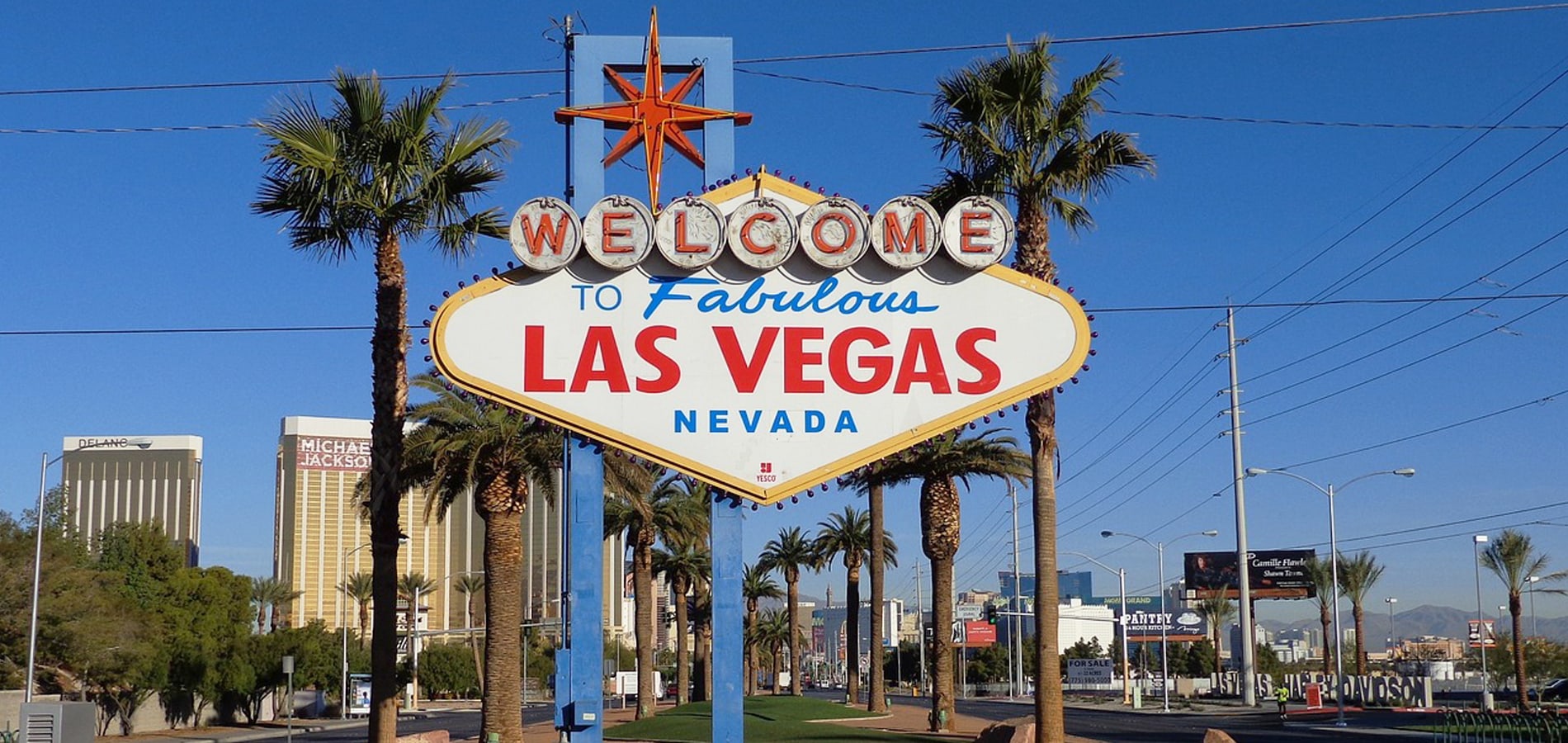

"landscape gallery Las Vegas","Achieve remarkable results with landscape gallery Las Vegas. Professionals in this region craft visually appealing, water-conscious environments well-suited to desert conditions. Best Landscaping Las Vegas Nevada. By blending native plants, rock formations, and efficient irrigation, you can establish a long-lasting outdoor retreat. Many companies focus on resource-saving techniques, including drip irrigation and drought-resistant plants. Customers can enjoy sustainable, vibrant spaces that also reduce water usage and routine upkeep. Whether you prefer minimalistic rock gardens or lush greenery, skilled experts can tailor designs to your taste. Thoughtful lighting and smart controllers help create an appealing ambiance while maximizing efficiency. Expert Landscaping Services in Las Vegas Nevada. Simple additions, like seating areas or decorative pavers, can turn unused corners into welcoming havens. Incorporating region-specific materials leads to seamless integration with the surrounding desert environment. Our proven expertise in landscape gallery Las Vegas ensures that each project receives a tailored approach. Ultimately, careful planning and professional expertise guarantee outstanding outdoor transformations."
"landscape portfolio Las Vegas","Optimize your property through landscape portfolio Las Vegas. Professionals in this region craft visually appealing, water-conscious environments well-suited to desert conditions. By blending native plants, rock formations, and efficient irrigation, you can establish a long-lasting outdoor retreat. Many companies focus on resource-saving techniques, including drip irrigation and drought-resistant plants. Customers can enjoy sustainable, vibrant spaces that also reduce water usage and routine upkeep. Whether you prefer minimalistic rock gardens or lush greenery, skilled experts can tailor designs to your taste. Thoughtful lighting and smart controllers help create an appealing ambiance while maximizing efficiency. Simple additions, like seating areas or decorative pavers, can turn unused corners into welcoming havens. Incorporating region-specific materials leads to seamless integration with the surrounding desert environment. Our proven expertise in landscape portfolio Las Vegas ensures that each project receives a tailored approach. Ultimately, careful planning and professional expertise guarantee outstanding outdoor transformations."
"landscape estimates Las Vegas","Reach new heights of design with landscape estimates Las Vegas. Many companies focus on resource-saving techniques, including drip irrigation and drought-resistant plants. Professionals in this region craft visually appealing, water-conscious environments well-suited to desert conditions. By blending native plants, rock formations, and efficient irrigation, you can establish a long-lasting outdoor retreat. Customers can enjoy sustainable, vibrant spaces that also reduce water usage and routine upkeep. Whether you prefer minimalistic rock gardens or lush greenery, skilled experts can tailor designs to your taste. Thoughtful lighting and smart controllers help create an appealing ambiance while maximizing efficiency. Simple additions, like seating areas or decorative pavers, can turn unused corners into welcoming havens. Incorporating region-specific materials leads to seamless integration with the surrounding desert environment. Our proven expertise in landscape estimates Las Vegas ensures that each project receives a tailored approach. Ultimately, careful planning and professional expertise guarantee outstanding outdoor transformations."
"landscape quotes Las Vegas","Combine style and function in landscape quotes Las Vegas. Professionals in this region craft visually appealing, water-conscious environments well-suited to desert conditions. By blending native plants, rock formations, and efficient irrigation, you can establish a long-lasting outdoor retreat. Many companies focus on resource-saving techniques, including drip irrigation and drought-resistant plants. Customers can enjoy sustainable, vibrant spaces that also reduce water usage and routine upkeep. Whether you prefer minimalistic rock gardens or lush greenery, skilled experts can tailor designs to your taste. Thoughtful lighting and smart controllers help create an appealing ambiance while maximizing efficiency. Simple additions, like seating areas or decorative pavers, can turn unused corners into welcoming havens. Incorporating region-specific materials leads to seamless integration with the surrounding desert environment. Our proven expertise in landscape quotes Las Vegas ensures that each project receives a tailored approach. Ultimately, careful planning and professional expertise guarantee outstanding outdoor transformations."
"landscape pricing Las Vegas","Unleash the full beauty of landscape pricing Las Vegas. Professionals in this region craft visually appealing, water-conscious environments well-suited to desert conditions. By blending native plants, rock formations, and efficient irrigation, you can establish a long-lasting outdoor retreat. Many companies focus on resource-saving techniques, including drip irrigation and drought-resistant plants. Customers can enjoy sustainable, vibrant spaces that also reduce water usage and routine upkeep. Whether you prefer minimalistic rock gardens or lush greenery, skilled experts can tailor designs to your taste. Thoughtful lighting and smart controllers help create an appealing ambiance while maximizing efficiency. Simple additions, like seating areas or decorative pavers, can turn unused corners into welcoming havens. Incorporating region-specific materials leads to seamless integration with the surrounding desert environment. Top Landscaping in Las Vegas Nevada. Our proven expertise in landscape pricing Las Vegas ensures that each project receives a tailored approach. Ultimately, careful planning and professional expertise guarantee outstanding outdoor transformations."
"landscape cost Las Vegas","Embrace the possibilities with landscape cost Las Vegas. Many companies focus on resource-saving techniques, including drip irrigation and drought-resistant plants. Customers can enjoy sustainable, vibrant spaces that also reduce water usage and routine upkeep. Professionals in this region craft visually appealing, water-conscious environments well-suited to desert conditions. By blending native plants, rock formations, and efficient irrigation, you can establish a long-lasting outdoor retreat. Simple additions, like seating areas or decorative pavers, can turn unused corners into welcoming havens. Whether you prefer minimalistic rock gardens or lush greenery, skilled experts can tailor designs to your taste. Thoughtful lighting and smart controllers help create an appealing ambiance while maximizing efficiency. Incorporating region-specific materials leads to seamless integration with the surrounding desert environment. Our proven expertise in landscape cost Las Vegas ensures that each project receives a tailored approach. Ultimately, careful planning and professional expertise guarantee outstanding outdoor transformations."
"landscape budget Las Vegas","Optimize your property through landscape budget Las Vegas. Professionals in this region craft visually appealing, water-conscious environments well-suited to desert conditions. By blending native plants, rock formations, and efficient irrigation, you can establish a long-lasting outdoor retreat. Best Landscaping Nevada USA. Many companies focus on resource-saving techniques, including drip irrigation and drought-resistant plants. Customers can enjoy sustainable, vibrant spaces that also reduce water usage and routine upkeep. Whether you prefer minimalistic rock gardens or lush greenery, skilled experts can tailor designs to your taste. Thoughtful lighting and smart controllers help create an appealing ambiance while maximizing efficiency. Simple additions, like seating areas or decorative pavers, can turn unused corners into welcoming havens. Incorporating region-specific materials leads to seamless integration with the surrounding desert environment. Our proven expertise in landscape budget Las Vegas ensures that each project receives a tailored approach. Ultimately, careful planning and professional expertise guarantee outstanding outdoor transformations."
"landscape project Las Vegas","Maximize every square foot with landscape project Las Vegas. Professionals in this region craft visually appealing, water-conscious environments well-suited to desert conditions. By blending native plants, rock formations, and efficient irrigation, you can establish a long-lasting outdoor retreat. Many companies focus on resource-saving techniques, including drip irrigation and drought-resistant plants. Customers can enjoy sustainable, vibrant spaces that also reduce water usage and routine upkeep. Whether you prefer minimalistic rock gardens or lush greenery, skilled experts can tailor designs to your taste. Thoughtful lighting and smart controllers help create an appealing ambiance while maximizing efficiency. Simple additions, like seating areas or decorative pavers, can turn unused corners into welcoming havens. Incorporating region-specific materials leads to seamless integration with the surrounding desert environment. Our proven expertise in landscape project Las Vegas ensures that each project receives a tailored approach. Ultimately, careful planning and professional expertise guarantee outstanding outdoor transformations."
"landscape development Las Vegas","Infuse creativity into landscape development Las Vegas. Many companies focus on resource-saving techniques, including drip irrigation and drought-resistant plants. Customers can enjoy sustainable, vibrant spaces that also reduce water usage and routine upkeep. Professionals in this region craft visually appealing, water-conscious environments well-suited to desert conditions. By blending native plants, rock formations, and efficient irrigation, you can establish a long-lasting outdoor retreat. Simple additions, like seating areas or decorative pavers, can turn unused corners into welcoming havens. Whether you prefer minimalistic rock gardens or lush greenery, skilled experts can tailor designs to your taste. Thoughtful lighting and smart controllers help create an appealing ambiance while maximizing efficiency. Incorporating region-specific materials leads to seamless integration with the surrounding desert environment. Our proven expertise in landscape development Las Vegas ensures that each project receives a tailored approach. Ultimately, careful planning and professional expertise guarantee outstanding outdoor transformations."
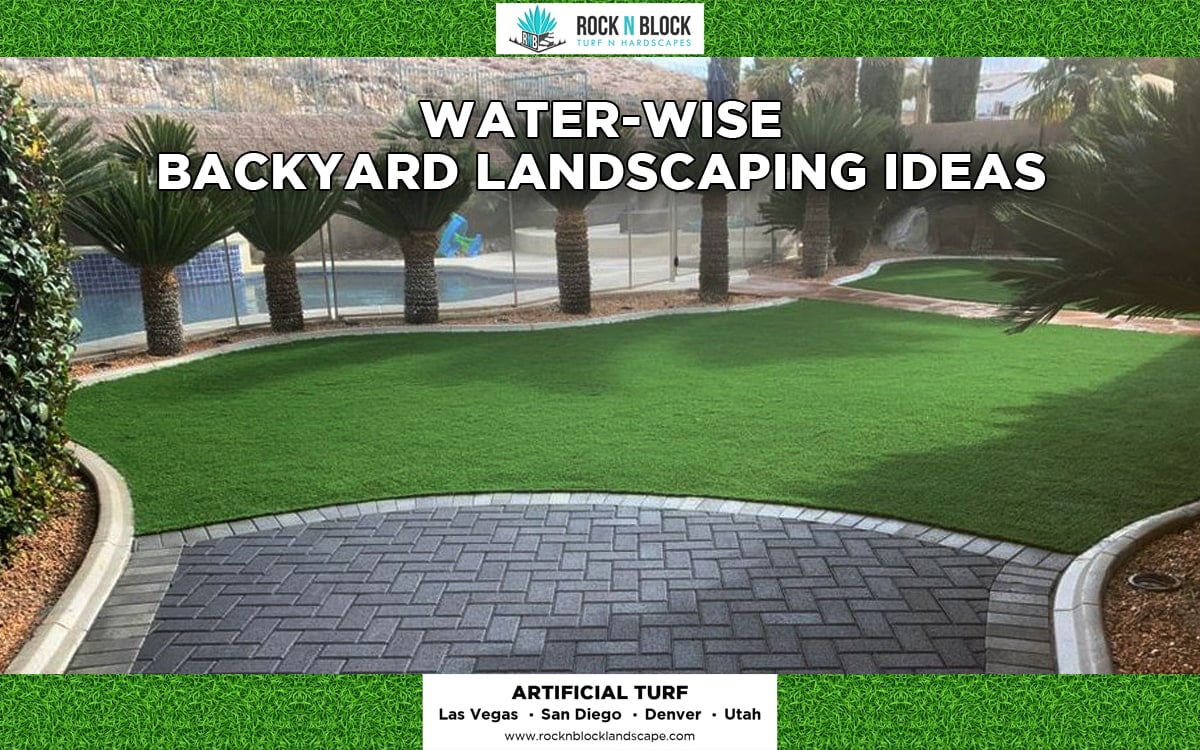
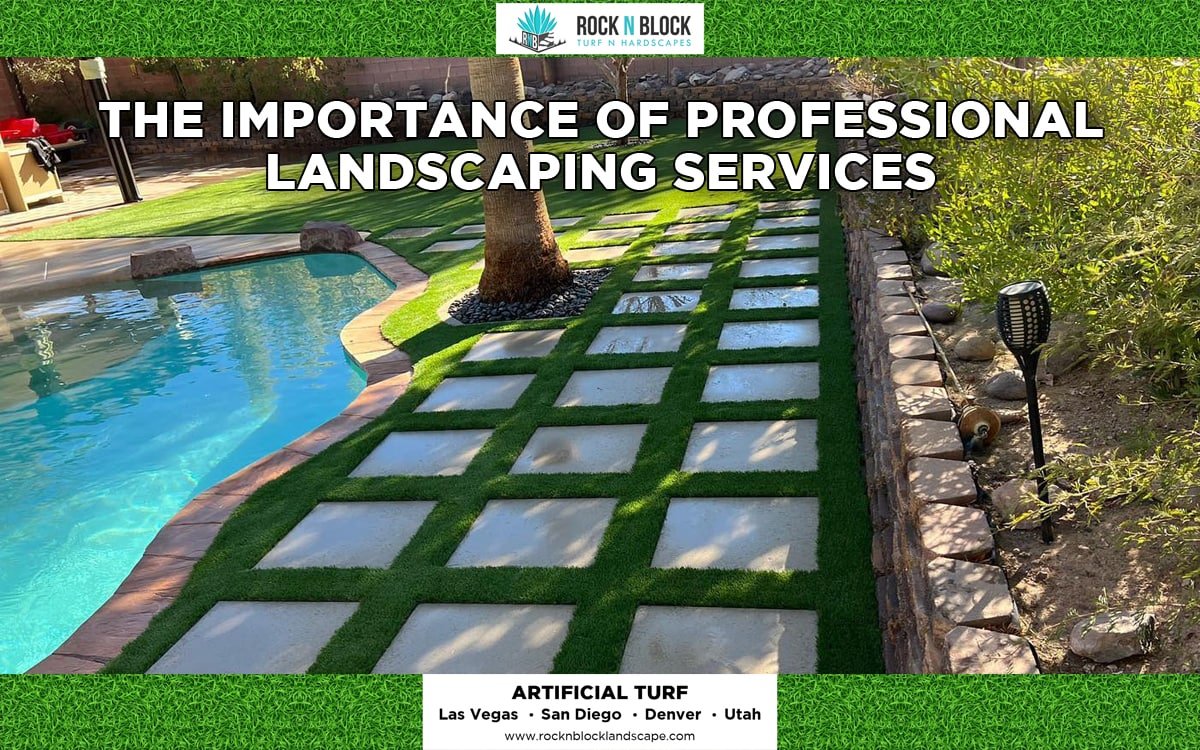
"landscape improvement Las Vegas","Enhance curb appeal via landscape improvement Las Vegas. Professionals in this region craft visually appealing, water-conscious environments well-suited to desert conditions. By blending native plants, rock formations, and efficient irrigation, you can establish a long-lasting outdoor retreat. Many companies focus on resource-saving techniques, including drip irrigation and drought-resistant plants. Customers can enjoy sustainable, vibrant spaces that also reduce water usage and routine upkeep. Whether you prefer minimalistic rock gardens or lush greenery, skilled experts can tailor designs to your taste. Thoughtful lighting and smart controllers help create an appealing ambiance while maximizing efficiency. Simple additions, like seating areas or decorative pavers, can turn unused corners into welcoming havens. Incorporating region-specific materials leads to seamless integration with the surrounding desert environment. Our proven expertise in landscape improvement Las Vegas ensures that each project receives a tailored approach. Ultimately, careful planning and professional expertise guarantee outstanding outdoor transformations."
"landscape enhancement Las Vegas","Reinvent your exterior with landscape enhancement Las Vegas. Many companies focus on resource-saving techniques, including drip irrigation and drought-resistant plants. Professionals in this region craft visually appealing, water-conscious environments well-suited to desert conditions. By blending native plants, rock formations, and efficient irrigation, you can establish a long-lasting outdoor retreat. Customers can enjoy sustainable, vibrant spaces that also reduce water usage and routine upkeep. Whether you prefer minimalistic rock gardens or lush greenery, skilled experts can tailor designs to your taste. Thoughtful lighting and smart controllers help create an appealing ambiance while maximizing efficiency. Simple additions, like seating areas or decorative pavers, can turn unused corners into welcoming havens. Incorporating region-specific materials leads to seamless integration with the surrounding desert environment. Our proven expertise in landscape enhancement Las Vegas ensures that each project receives a tailored approach. Ultimately, careful planning and professional expertise guarantee outstanding outdoor transformations."
"landscape transformation Las Vegas","Reinvent your exterior with landscape transformation Las Vegas. Nevada Las Vegas Landscaping Services. Professionals in this region craft visually appealing, water-conscious environments well-suited to desert conditions. By blending native plants, rock formations, and efficient irrigation, you can establish a long-lasting outdoor retreat. Many companies focus on resource-saving techniques, including drip irrigation and drought-resistant plants. Customers can enjoy sustainable, vibrant spaces that also reduce water usage and routine upkeep. Whether you prefer minimalistic rock gardens or lush greenery, skilled experts can tailor designs to your taste. Thoughtful lighting and smart controllers help create an appealing ambiance while maximizing efficiency.
"landscape makeover Las Vegas","Reach new heights of design with landscape makeover Las Vegas. Many companies focus on resource-saving techniques, including drip irrigation and drought-resistant plants. Professionals in this region craft visually appealing, water-conscious environments well-suited to desert conditions. By blending native plants, rock formations, and efficient irrigation, you can establish a long-lasting outdoor retreat. Customers can enjoy sustainable, vibrant spaces that also reduce water usage and routine upkeep. Whether you prefer minimalistic rock gardens or lush greenery, skilled experts can tailor designs to your taste. Thoughtful lighting and smart controllers help create an appealing ambiance while maximizing efficiency. Simple additions, like seating areas or decorative pavers, can turn unused corners into welcoming havens. Incorporating region-specific materials leads to seamless integration with the surrounding desert environment. Our proven expertise in landscape makeover Las Vegas ensures that each project receives a tailored approach. Ultimately, careful planning and professional expertise guarantee outstanding outdoor transformations."
"landscape upgrade Las Vegas","Unlock sustainable benefits through landscape upgrade Las Vegas. Many companies focus on resource-saving techniques, including drip irrigation and drought-resistant plants. Customers can enjoy sustainable, vibrant spaces that also reduce water usage and routine upkeep. Professionals in this region craft visually appealing, water-conscious environments well-suited to desert conditions. By blending native plants, rock formations, and efficient irrigation, you can establish a long-lasting outdoor retreat. Simple additions, like seating areas or decorative pavers, can turn unused corners into welcoming havens. Whether you prefer minimalistic rock gardens or lush greenery, skilled experts can tailor designs to your taste. Thoughtful lighting and smart controllers help create an appealing ambiance while maximizing efficiency. Incorporating region-specific materials leads to seamless integration with the surrounding desert environment. Our proven expertise in landscape upgrade Las Vegas ensures that each project receives a tailored approach. Ultimately, careful planning and professional expertise guarantee outstanding outdoor transformations."

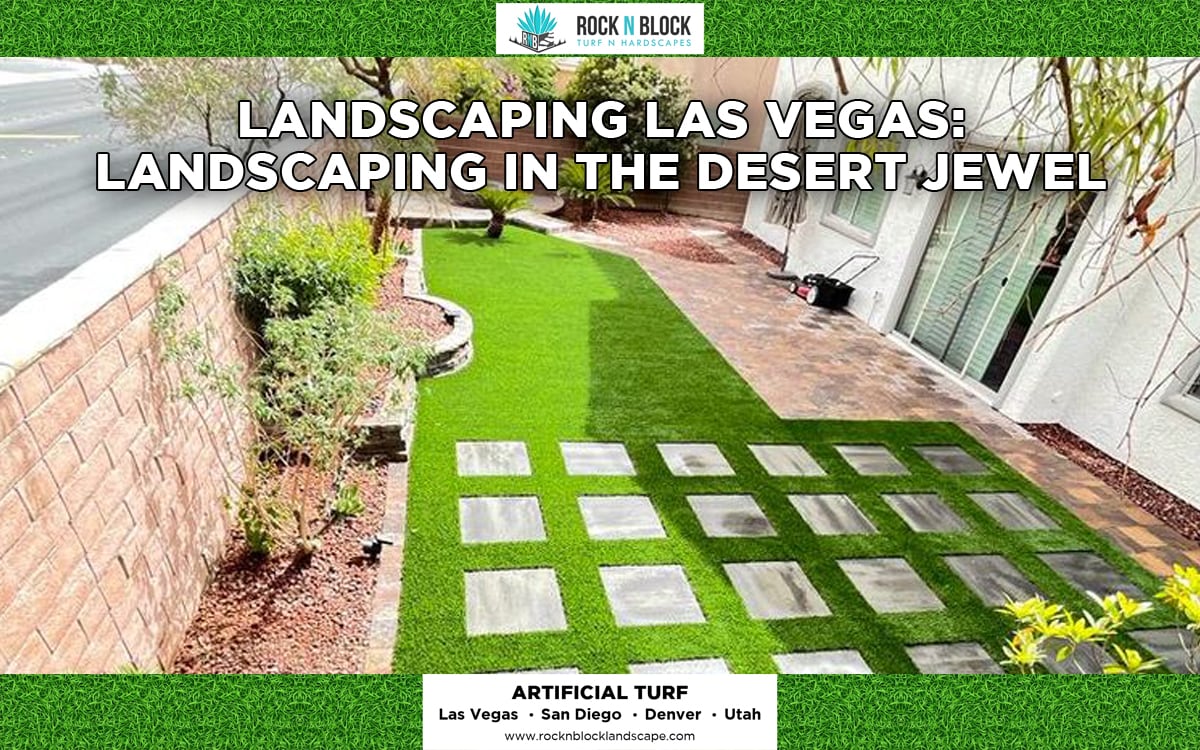
"Landscaping Las Vegas","Elevate your surroundings through Landscaping Las Vegas. Professionals in this region craft visually appealing, water-conscious environments well-suited to desert conditions. By blending native plants, rock formations, and efficient irrigation, you can establish a long-lasting outdoor retreat. Many companies focus on resource-saving techniques, including drip irrigation and drought-resistant plants. Customers can enjoy sustainable, vibrant spaces that also reduce water usage and routine upkeep. Whether you prefer minimalistic rock gardens or lush greenery, skilled experts can tailor designs to your taste. Thoughtful lighting and smart controllers help create an appealing ambiance while maximizing efficiency. Simple additions, like seating areas or decorative pavers, can turn unused corners into welcoming havens. Incorporating region-specific materials leads to seamless integration with the surrounding desert environment. Our proven expertise in Landscaping Las Vegas ensures that each project receives a tailored approach. Ultimately, careful planning and professional expertise guarantee outstanding outdoor transformations."
"Landscaping Services inLas Vegas","Embrace the possibilities with Landscaping Services inLas Vegas. Professionals in this region craft visually appealing, water-conscious environments well-suited to desert conditions. By blending native plants, rock formations, and efficient irrigation, you can establish a long-lasting outdoor retreat. Many companies focus on resource-saving techniques, including drip irrigation and drought-resistant plants. Customers can enjoy sustainable, vibrant spaces that also reduce water usage and routine upkeep. Whether you prefer minimalistic rock gardens or lush greenery, skilled experts can tailor designs to your taste. Thoughtful lighting and smart controllers help create an appealing ambiance while maximizing efficiency. Simple additions, like seating areas or decorative pavers, can turn unused corners into welcoming havens. Incorporating region-specific materials leads to seamless integration with the surrounding desert environment. Our proven expertise in Landscaping Services inLas Vegas ensures that each project receives a tailored approach. Ultimately, careful planning and professional expertise guarantee outstanding outdoor transformations."
"Las Vegas landscaping","Infuse creativity into Las Vegas landscaping. Many companies focus on resource-saving techniques, including drip irrigation and drought-resistant plants. Customers can enjoy sustainable, vibrant spaces that also reduce water usage and routine upkeep. Whether you prefer minimalistic rock gardens or lush greenery, skilled experts can tailor designs to your taste. Professionals in this region craft visually appealing, water-conscious environments well-suited to desert conditions. By blending native plants, rock formations, and efficient irrigation, you can establish a long-lasting outdoor retreat.
"landscape design Las Vegas","Discover the potential of landscape design Las Vegas. By blending native plants, rock formations, and efficient irrigation, you can establish a long-lasting outdoor retreat. Professionals in this region craft visually appealing, water-conscious environments well-suited to desert conditions. Many companies focus on resource-saving techniques, including drip irrigation and drought-resistant plants. Customers can enjoy sustainable, vibrant spaces that also reduce water usage and routine upkeep. Whether you prefer minimalistic rock gardens or lush greenery, skilled experts can tailor designs to your taste. Thoughtful lighting and smart controllers help create an appealing ambiance while maximizing efficiency. Simple additions, like seating areas or decorative pavers, can turn unused corners into welcoming havens. Incorporating region-specific materials leads to seamless integration with the surrounding desert environment. Our proven expertise in landscape design Las Vegas ensures that each project receives a tailored approach. Ultimately, careful planning and professional expertise guarantee outstanding outdoor transformations."
"xeriscape Las Vegas","Achieve remarkable results with xeriscape Las Vegas. Many companies focus on resource-saving techniques, including drip irrigation and drought-resistant plants. Professionals in this region craft visually appealing, water-conscious environments well-suited to desert conditions. By blending native plants, rock formations, and efficient irrigation, you can establish a long-lasting outdoor retreat. Customers can enjoy sustainable, vibrant spaces that also reduce water usage and routine upkeep. Whether you prefer minimalistic rock gardens or lush greenery, skilled experts can tailor designs to your taste. Thoughtful lighting and smart controllers help create an appealing ambiance while maximizing efficiency. Simple additions, like seating areas or decorative pavers, can turn unused corners into welcoming havens. Incorporating region-specific materials leads to seamless integration with the surrounding desert environment. Our proven expertise in xeriscape Las Vegas ensures that each project receives a tailored approach. Ultimately, careful planning and professional expertise guarantee outstanding outdoor transformations."
"landscaping companies Las Vegas","Discover the potential of landscaping companies Las Vegas. Professionals in this region craft visually appealing, water-conscious environments well-suited to desert conditions. By blending native plants, rock formations, and efficient irrigation, you can establish a long-lasting outdoor retreat. Many companies focus on resource-saving techniques, including drip irrigation and drought-resistant plants. Customers can enjoy sustainable, vibrant spaces that also reduce water usage and routine upkeep. Whether you prefer minimalistic rock gardens or lush greenery, skilled experts can tailor designs to your taste. Thoughtful lighting and smart controllers help create an appealing ambiance while maximizing efficiency. Simple additions, like seating areas or decorative pavers, can turn unused corners into welcoming havens. Incorporating region-specific materials leads to seamless integration with the surrounding desert environment. Our proven expertise in landscaping companies Las Vegas ensures that each project receives a tailored approach. Ultimately, careful planning and professional expertise guarantee outstanding outdoor transformations."
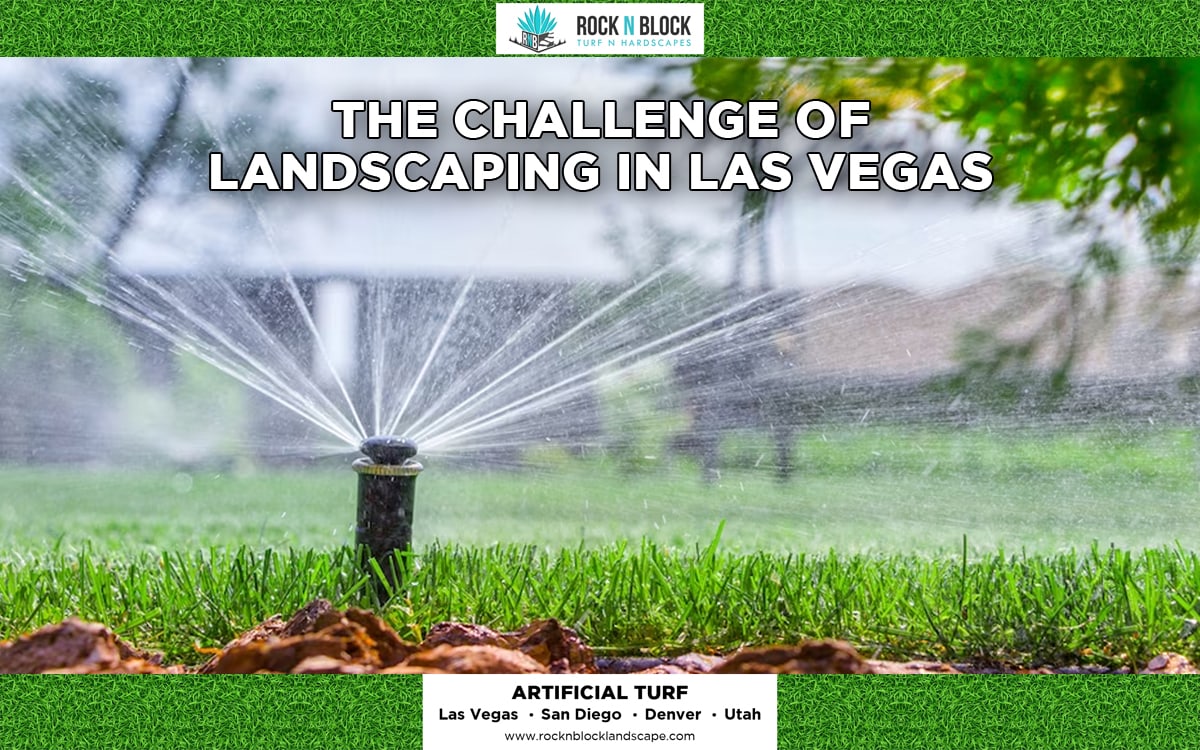
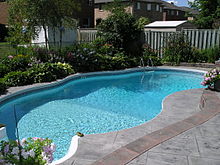

A swimming pool, swimming bath, wading pool, paddling pool, or simply pool, is a structure designed to hold water to enable swimming and associated activities. Pools can be built into the ground (in-ground pools) or built above ground (as a freestanding construction or as part of a building or other larger structure), and may be found as a feature aboard ships. In-ground pools are most commonly constructed from materials such as concrete, natural stone, metal, plastic, composite or fiberglass, and may follow a standardized size, the largest of which is the Olympic-size swimming pool, or be of a custom shape.
Many health clubs, fitness centers, and private clubs have pools for their members, often used for exercise. In much of the world, local governments provide publicly-run pools for their citizens. Many of these are outdoors; indoor pools are typically part of a leisure centre. Many hotels have a pool for the use of their guests. Pools as a feature in hotels are more common in tourist areas or near convention centers. Many universities and other institutional communities provide pools for their members., often as part of an institution-specific athletic or recreational complex. Apartment complexes and residential subdivisions may provide a pool for the use of their residents. Private residences, particularly in areas with warm climates, may have their own pools.
Educational facilities such as high schools and universities often have pools for physical education classes, recreational activities, leisure, and competitive athletics such as swimming teams. Hot tubs and spas are small heated pools used for relaxation or hydrotherapy. Specialised pools are also used for diving, water sports, and physical therapy, as well as for training of lifeguards and astronauts. Swimming pools most commonly use chlorinated water, or salt water, and may be heated or unheated.
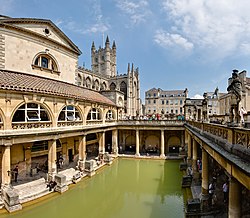
The "Great Bath" at the site of Mohenjo-Daro in modern-day Pakistan was most likely the first swimming pool, dug during the 3rd millennium BC. This pool is 12 by 7 metres (39 by 23 feet), is lined with bricks, and was covered with a tar-based sealant.[1]
Ancient Greeks and Romans built artificial pools for athletic training in the palaestras, for nautical games and for military exercises. Roman emperors had private swimming pools in which fish were also kept, hence one of the Latin words for a pool was piscina. The first heated swimming pool was built by Gaius Maecenas in his gardens on the Esquiline Hill of Rome, likely sometime between 38 and 8 BC.[2] Gaius Maecenas was a wealthy imperial advisor to Augustus and considered one of the first patrons of arts.[3]
Ancient Sinhalese built a pair of pools called "Kuttam Pokuna" in the kingdom of Anuradhapura, Sri Lanka, in the 6th century AD. They were decorated with flights of steps, punkalas or pots of abundance, and scroll design.[4][5]
Swimming pools became popular in Britain in the mid-19th century. As early as 1837, six indoor pools with diving boards existed in London, England.[6] The Maidstone Swimming Club in Maidstone, Kent is believed to be the oldest surviving swimming club in Britain. It was formed in 1844, in response to concerns over drownings in the River Medway, especially since would-be rescuers would often drown because they themselves could not swim to safety. The club used to swim in the River Medway, and would hold races, diving competitions and water polo matches. The South East Gazette July 1844 reported an aquatic breakfast party: coffee and biscuits were served on a floating raft in the river. The coffee was kept hot over a fire; club members had to tread water and drink coffee at the same time. The last swimmers managed to overturn the raft, to the amusement of 150 spectators.[7]
The Amateur Swimming Association was founded in 1869 in England,[citation needed] and the Oxford Swimming Club in 1909.[8] The presence of indoor baths in the cobbled area of Merton Street might have persuaded the less hardy of the aquatic brigade to join. So, bathers gradually became swimmers, and bathing pools became swimming pools.[citation needed] In 1939, Oxford created its first major public indoor pool at Temple Cowley.
The modern Olympic Games started in 1896 and included swimming races, after which the popularity of swimming pools began to spread. In the US, the Racquet Club of Philadelphia clubhouse (1907) boasts one of the world's first modern above-ground swimming pools. The first swimming pool to go to sea on an ocean liner was installed on the White Star Line's Adriatic in 1906.[9] The oldest known public swimming pool in the U.S., Underwood Pool, is located in Belmont, Massachusetts.[10]

Interest in competitive swimming grew following World War I. Standards improved and training became essential. Home swimming pools became popular in the United States after World War II and the publicity given to swimming sports by Hollywood films such as Esther Williams' Million Dollar Mermaid made a home pool a desirable status symbol. More than 50 years later, the home or residential swimming pool is a common sight. Some small nations enjoy a thriving swimming pool industry (e.g., New Zealand pop. 4,116,900 – holds the record in pools per capita with 65,000 home swimming pools and 125,000 spa pools).[12]
A two-storey, white concrete swimming pool building composed of horizontal cubic volumes built in 1959 at the Royal Roads Military College is on the Canadian Register of Historic Places.[13]

According to the Guinness World Records, the largest swimming pool in the world is San Alfonso del Mar Seawater pool in Algarrobo, Chile. It is 1,013 m (3,323 ft) long and has an area of 8 ha (20 acres). At its deepest, it is 3.5 m (11 ft) deep.[14] It was completed in December 2006.[15]
The largest indoor wave pool in the world is at DreamWorks Water Park within the American Dream shopping and entertainment complex at the Meadowlands Sports Complex in East Rutherford, New Jersey, United States, and the largest indoor pool in North America is at the Neutral Buoyancy Lab in the Sonny Carter Training Facility at NASA JSC in Houston.[16][17]
In 2021, Deep Dive Dubai, located in Dubai, UAE, was certified by the Guinness Book of World Records as the world's deepest swimming pool reaching 60 metres (200 ft).[18][19] The Y-40 swimming pool at the Hotel Terme Millepini in Padua, Italy, previously held the record, 42.15 m (138.3 ft), from 2014 until 2021.[20]
The Fleishhacker Pool in San Francisco was the largest heated outdoor swimming pool in the United States. Opened on 23 April 1925, it measured 1,000 by 150 ft (300 by 50 m) and was so large that the lifeguards required kayaks for patrol. It was closed in 1971 due to low patronage.[21]
In Europe, the largest swimming pool opened in 1934 in ElblÄ…g (Poland), providing a water area of 33,500 square metres (361,000 sq ft).[22]
One of the largest swimming pools ever built was reputedly created in Moscow after the Palace of Soviets remained uncompleted. The foundations of the palace were converted into the Moskva Pool open-air swimming pool after the process of de-Stalinisation.[23] However, after the fall of communism, Christ the Saviour Cathedral was re-built on the site between 1995 and 2000; the cathedral had originally been located there.[citation needed]
The highest swimming pool is believed to be in Yangbajain (Tibet, China). This resort is located at 4,200 m (13,800 ft) AMSL and has two indoor swimming pools and one outdoor swimming pool, all filled with water from hot springs.[24]


Length: Most pools in the world are measured in metres, but in the United States pools are often measured in feet and yards. In the UK most pools are calibrated in metres, but older pools measured in yards still exist. In the US, pools tend to either be 25 yards (SCY-short course yards), 25 metres (SCM-short course metres) or 50 metres (LCM - long course meters). US high schools and the NCAA conduct short course (25 yards) competition. There are also many pools 33+1⁄3 m long, so that 3 lengths = 100 m. This pool dimension is commonly used to accommodate water polo.[citation needed]
USA Swimming (USA-S) swims in both metric and non-metric pools. However, the international standard is metres, and world records are only recognized when swum in 50 m pools (or 25 m for short course) but 25-yard pools are very common in the US. In general, the shorter the pool, the faster the time for the same distance, since the swimmer gains speed from pushing off the wall after each turn at the end of the pool.
Width: The width of the pool depends on the number of swimming lanes and the width of each individual lane. In an Olympic swimming pool each lane is 2.5 meters wide[25] and contains 10 lanes, thus making the pool 25 meters wide.
Depth: The depth of a swimming pool depends on the purpose of the pool, and whether it is open to the public or strictly for private use. If it is a private casual, relaxing pool, it may go from 1.0 to 2.0 m (3.3 to 6.6 ft) deep. If it is a public pool designed for diving, it may slope from 3.0 to 5.5 m (10 to 18 ft) in the deep end. A children's play pool may be from 0.3 to 1.2 m (1 to 4 ft) deep. Most public pools have differing depths to accommodate different swimmer requirements. In many jurisdictions, it is a requirement to show the water depth with clearly marked depths affixed to the pool walls,[26][27] although this may not be the case for private pools in some jurisdictions.[28]

Pools can be either indoors or outdoors. They can be of any size and shape, and inground or above ground. Most pools are permanent fixtures, while others are temporary, collapsible structures.

Private pools are usually smaller than public pools, on average 3.7 m × 7.3 m (12 ft × 24 ft) to 6.1 m × 12.2 m (20 ft × 40 ft) whereas public pools usually start at 20 m (66 ft).[citation needed] Home pools can be permanently built-in, or be assembled above ground and disassembled after summer. Privately owned outdoor pools in backyards or gardens started to proliferate in the 1950s in regions with warm summer climates, particularly in the United States with desegregation.[29] A plunge pool is a smaller, permanently installed swimming pool, with a maximum size of approximately 3 m × 6 m (10 ft × 20 ft).[30][31][32]
Construction methods for private pools vary greatly. The main types of in-ground pools are gunite shotcrete, concrete, vinyl-lined, and one-piece fiberglass shells.
Many countries now have strict pool fencing requirements for private swimming pools, which require pool areas to be isolated so that unauthorized children younger than six years cannot enter. Many countries require a similar level of protection for the children residing in or visiting the house, although many pool owners prefer the visual aspect of the pool in close proximity to their living areas, and will not provide this level of protection. There is no consensus between states or countries on the requirements to fence private swimming pools, and in many places they are not required at all, particularly in rural settings.[33]
Inexpensive temporary polyvinyl chloride pools can be bought in supermarkets and taken down after summer. They are used mostly outdoors in yards, are typically shallow, and often their sides are inflated with air to stay rigid. When finished, the water and air can be let out and this type of pool can be folded up for convenient storage. They are regarded in the swimming pool industry as "splasher" pools intended for cooling off and amusing toddlers and children, not for swimming, hence the alternate name of "kiddie" pools.[citation needed]
Toys are available for children and other people to play with in pool water. They are often blown up with air so they are soft but still reasonably rugged, and can float in water.


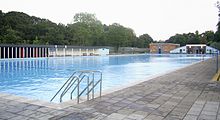
Public pools are often part of a larger leisure center or recreational complex. These centres often have more than one pool, such as an indoor heated pool, an outdoor (chlorinated, saltwater or ozonated) pool which may be heated or unheated, a shallower children's pool, and a paddling pool for toddlers and infants. There may also be a sauna and one or more hot tubs or spa pools ("jacuzzis").
Many upscale hotels and holiday resorts have a swimming pool for use by their guests. If a pool is in a separate building, the building may be called a natatorium. The building may sometimes also have facilities for related activities, such as a diving tank. Larger pools sometimes have a diving board affixed at one edge above the water.
Many public swimming pools are rectangles 25 m or 50 m long, but they can be any size and shape. There are also elaborate pools with artificial waterfalls, fountains, splash pads, wave machines, varying depths of water, bridges, and island bars.

Some swimming facilities have lockers for clothing and other belongings. The lockers can require a coin to be inserted in a slot, either as deposit or payment. There are usually showers – sometimes mandatory – before and/or after swimming. There are often also lifeguards to ensure the safety of users.
Wading or paddling pools are shallow bodies of water intended for use by small children, usually in parks. Concrete wading pools come in many shapes, traditionally rectangle, square or circle. Some are filled and drained daily due to lack of a filter system. Staff chlorinate the water to ensure health and safety standards.[citation needed]


The Fédération Internationale de la Natation (FINA, International Swimming Federation) sets standards for competition pools: 25 or 50 m (82 or 164 ft) long and at least 1.35 m (4.4 ft) deep. Competition pools are generally indoors and heated to enable their use all year round, and to more easily comply with the regulations regarding temperature, lighting, and automatic officiating equipment.
An Olympic-size swimming pool (first used at the 1924 Olympics) is a pool that meets FINA's additional standards for the Olympic Games and for world championship events. It must be 50 by 25 m (164 by 82 ft) wide, divided into eight lanes of 2.5 m (8.2 ft) each, plus two areas of 2.5 m (8.2 ft) at each side of the pool. Depth must be at least 2 m (6.6 ft).[34]
The water must be kept at 25–28 °C (77–82 °F) and the lighting level at greater than 1500 lux. There are also regulations for color of lane rope, positioning of backstroke flags (5 metres from each wall), and so on.[34] Pools claimed to be "Olympic pools" do not always meet these regulations, as FINA cannot police use of the term. Touchpads are mounted on both walls for long course meets and each end for short course.
A pool may be referred to as fast or slow, depending on its physical layout.[35] Some design considerations allow the reduction of swimming resistance making the pool faster: namely, proper pool depth, elimination of currents, increased lane width, energy absorbing racing lane lines and gutters, and the use of other innovative hydraulic, acoustic and illumination designs.

In the last two decades, a new style of pool has gained popularity. These consist of a small vessel (usually about 2.5 × 5 m) in which the swimmer swims in place, either against the push of an artificially generated water current or against the pull of restraining devices. These pools have several names, such as swim spas, swimming machines, or swim systems. They are all examples of different modes of resistance swimming.

Hot tubs and spa pools are common heated pools used for relaxation and sometimes for therapy. Commercial spas are common in the swimming pool area or sauna area of a health club or fitness center, in men's clubs, women's clubs, motels and exclusive five-star hotel suites. Spa clubs may have very large pools, some segmented into increasing temperatures. In Japan, men's clubs with many spas of different size and temperature are common.
Commercial spas are generally made of concrete, with a mosaic tiled interior. More recently[when?] with the innovation of the pre-form composite method where mosaic tiles are bonded to the shell this enables commercial spas to be completely factory manufactured to specification and delivered in one piece. Hot tubs are typically made somewhat like a wine barrel with straight sides, from wood such as Californian redwood held in place by metal hoops. Immersion of the head is not recommended in spas or hot tubs due to a potential risk of underwater entrapment from the pump suction forces. However, commercial installations in many countries must comply with various safety standards which reduce this risk considerably.

Home spas are a worldwide retail item in western countries since the 1980s, and are sold in dedicated spa stores, pool shops, department stores, the Internet, and catalog sales books. They are almost always made from heat-extruded acrylic sheet Perspex, often colored in marble look-alike patterns. They rarely exceed 6 m2 (65 sq ft) and are typically 1 m (3 ft 3 in) deep, restricted by the availability of the raw sheet sizes (typically manufactured in Japan). There is often a mid-depth seating or lounging system, and contoured lounger style reclining seats are common.
Upmarket spas often include a drinks tray, lights, LCD flat-screen TV sets and other features that make the pool a recreation center. Due to their family-oriented nature, home spas are normally operated from 36 to 39 °C (97 to 102 °F). Many pools are incorporated in a redwood or simulated wood surround, and are termed "portable" as they may be placed on a patio rather than sunken into a permanent location. Some portable spas are shallow and narrow enough to fit sideways through a standard door and be used inside a room. Low power electric immersion heaters are common with home spas.
Whirlpool tubs first became popular in the U.S. during the 1960s and 1970s. A spa is also called a "jacuzzi" there, as the word became a generic after-plumbing component manufacturer; Jacuzzi introduced the "spa whirlpool" in 1968. Air bubbles may be introduced into the nozzles via an air-bleed venturi pump that combines cooler air with the incoming heated water to cool the pool if the temperature rises uncomfortably high. Some spas have a constant stream of bubbles fed via the seating area of the pool, or a footwell area. This is more common as a temperature control device where the heated water comes from a natural (uncontrolled heat) geothermal source, rather than artificially heated.
Water temperature is usually very warm to hot – 38 to 42 °C (100 to 108 °F) – so bathers usually stay in for only 20 to 30 minutes. Bromine or mineral sanitizers are often recommended as sanitizers for spas because chlorine dissipates at a high temperature, thereby heightening its strong chemical smell. Ozone is an effective bactericide and is commonly included in the circulation system with cartridge filtration, but not with sand media filtration due to clogging problems with turbid body fats.

In the early 20th century, especially in Australia, ocean pools were built, typically on headlands by enclosing part of the rock shelf, with water circulated through the pools by flooding from tidal tanks or by regular flooding over the side of the pools at high tide. This continued a pre-European tradition of bathing in rockpools with many of the current sites being expanded from sites used by Aboriginal Australians or early European settlers. Bathing in these pools provided security against both rough surf and sea life. There were often separate pools for women and men, or the pool was open to the sexes at different times with a break for bathers to climb in without fear of observation by the other sex.[36] These were the forerunners of modern "Olympic" pools. A variation was the later development of sea- or harbour-side pools that circulated sea water using pumps. A pool of this type was the training ground for Australian Olympian Dawn Fraser.
There are currently about 100 ocean baths in New South Wales, which can range from small pools roughly 25 metres long and "Olympic Sized" (50m) to the very large, such as the 50 × 100 m baths in Newcastle. While most are free, a number charge fees, such as the Bondi Icebergs Club pool at Bondi Beach. Despite the development of chlorinated and heated pools, ocean baths remain a popular form of recreation in New South Wales.
A semi-natural ocean pool exists on the central coast of New South Wales; it is called The Bogey Hole.
An infinity pool (also named negative edge or vanishing edge pool) is a swimming pool which produces a visual effect of water extending to the horizon, vanishing, or extending to "infinity". Often, the water appears to fall into an ocean, lake, bay, or other similar body of water. The illusion is most effective whenever there is a significant change in elevation, though having a natural body of water on the horizon is not a limiting factor.[citation needed]
Natural pools were developed in central and western Europe in the early and mid-1980s by designers and landscape architects with environmental concerns. They have recently been growing in popularity as an alternative to traditional swimming pools.[37][38] Natural pools are constructed bodies of water in which no chemicals or devices that disinfect or sterilize water are used, and all the cleaning of the pool is achieved purely with the motion of the water through biological filters and plants rooted hydroponically in the system. In essence, natural pools seek to recreate swimming holes and swimmable lakes, the environment where people feel safe swimming in a non-polluted, healthy, and ecologically balanced body of water.
Water in natural pools has many desirable characteristics. For example, red eyes, dried-out skin and hair, and bleached swimsuits associated with overly chlorinated water are naturally absent in natural pools.[citation needed] Natural pools, by requiring a water garden to be a part of the system, offer different aesthetic options and can support amphibious wildlife such as snails, frogs, and salamanders, and even small fish if desired.

A zero-entry swimming pool, also called a beach entry swimming pool, has an edge or entry that gradually slopes from the deck into the water, becoming deeper with each step, in the manner of a natural beach. As there are no stairs or ladders to navigate, this type of entry assists older people, young children and people with accessibility problems (e.g., people with a physical disability) where gradual entry is useful.

Indoor pools are located inside a building with a roof and are insulated by at least three walls. Built for year-round swimming or training, they are found in all climate types. Since the buildings around indoor pools are insulated, heat escapes much less, making it less expensive to heat indoor pools than outdoor pools (all of whose heat escapes).[39]
Architecturally, an indoor pool may look like the rest of the building, but extra heating and ventilation and other engineering solutions are required to ensure comfortable humidity levels. In addition to drainage and automatic pool covers, there are a number of ways to remove the humidity present in the air in any wet indoor environment. Efficient dehumidification in the indoor pool environment prevents structural damage, lowers energy costs for cooling or heating, and improves the indoor climate to provide a comfortable swimming environment.[citation needed]
Some colleges, universities, and high schools have buildings that use the term "natatorium" in their names, especially when the building houses more than just a swimming pool, for example a diving well or facilities for water polo. The word natatorium was borrowed from Late Latin "place for swimming" into English in New England in 1890.[40][41]
This type of swimming pool is suspended high above the ground. A prominent example is the Sky Pool in London's Embassy Gardens, the world's first floating pool.[42]


Swimming pools are also used for events such as synchronized swimming, water polo, canoe polo and underwater sports such as underwater hockey, underwater rugby, finswimming and sport diving as well as for teaching diving, lifesaving and scuba diving techniques. They have also been used for specialist tasks such as teaching water-ditching survival techniques for aircraft and submarine crews and astronaut training. Round-cornered, irregular swimming pools, such as the Nude Bowl, were drained of water and used for vertical skateboarding.

Levels of bacteria and viruses in swimming pool water must be kept low to prevent the spread of diseases and pathogens. Bacteria, algae and insect larvae can breed in the pool if water is not properly sanitized. Pumps, mechanical sand filters, and disinfectants are often used to sanitise the water.
Chemical disinfectants, such as chlorine (usually as a hypochlorite salt, such as calcium hypochlorite) and bromine, are commonly used to kill pathogens. If not properly maintained, chemical sanitation can produce high levels of disinfection byproducts. Sanitized swimming pool water can theoretically appear green if a certain amount of iron salts or copper chloride are present in the water.[43]
Acesulfame potassium has been used to estimate how much urine is discharged by swimmers into a pool.[44] A Canadian study estimated that swimmers had released 75 litres of urine into a large pool that had about 830,000 litres of water and was a third of the size of an olympic pool. Hot tubs were found to have higher readings of the marker. While urine itself is relatively harmless, its degradation products may lead to asthma.[44]
Swimming pool heating costs can be significantly reduced by using a pool cover. Use of a pool cover also can help reduce the amount of chemicals (chlorine, etc.) required by the pool. Outdoor pools gain heat from the sun, absorbing 75–85% of the solar energy striking the pool surface. Though a cover decreases the total amount of solar heat absorbed by the pool, the cover eliminates heat loss due to evaporation and reduces heat loss at night through its insulating properties. Most swimming pool heat loss is through evaporation.[45]
In areas which reach freezing temperature, it is important to close a pool properly. This varies greatly between in-ground and above-ground pools. By taking steps to properly secure the pool, it lessens the likelihood that the superstructure will be damaged or compromised by freezing water.[46]

In preparation for freezing temperatures, an in-ground swimming pool's pipes must be emptied. An above-ground pool should also be closed, so that ice does not drag down the pool wall, collapsing its structure. The plumbing is sealed with air, typically with rubber plugs, to prevent cracking from freezing water. The pool is typically covered to prevent leaves and other debris from falling in. The cover is attached to the pool typically using a stretch cord, similar to a bungee cord, and hooks fitted into the pool surround. The skimmer is closed off or a floating device is placed into it to prevent it from completely freezing and cracking.
Floating objects such as life rings or basketballs can be placed in the pool to avoid its freezing under the cover. Sand or DE filters must be backwashed, with the main drain plug removed and all water drained out. Drain plugs on the pool filter are removed after the filter has been cleaned. The pool pump motor is taken under cover. Winter chemicals are added to keep the pool clean. The innovation of a composite construction of fiberglass, with an epoxy coating and porcelain ceramic tiles has led to the pre-form, composite-type with significant advantages over older methods; however, it also has increased sensitivity to metal staining.[citation needed]
In climates where there is no risk of freezing, closing down the pool for winter is not so important. Typically, the thermal cover is removed and stored. Winter sunlight can create an algae mess when a cover that has been left on all winter is removed. The pool is correctly pH-balanced and super-chlorinated. One part algaecide for every 50,000 parts of pool water should be added, and topped up each month. The pool should be filtered for one to two hours daily to keep the automated chlorination system active.[citation needed]

Pools pose a risk of drowning, which may be significant for swimmers who are inexperienced, suffer from seizures, or are susceptible to a heart or respiratory condition. Lifeguards are employed at most pools to execute water rescues and administer first aid as needed in order to reduce this risk.
Diving in shallow areas of a pool may also lead to significant head and neck injuries; diving, especially head-first diving, should be done in the deepest point of the pool, minimally 2.4 m (7 ft 10 in), but desirably 3.7 m (12 ft), deeper if the distance between the water and the board is great.
Pools present a risk of death due to drowning particularly in young children. In regions where residential pools are common, drowning is a major cause of childhood death. As a precaution, many jurisdictions require that residential pools be enclosed with fencing to restrict unauthorized access. Many products exist, such as removable baby fences. The evidence for floating alarms and window/door alarms to reduce the risk of drowning is poor.[47] Some pools are equipped with computer-aided drowning prevention or other forms of electronic safety and security systems.
Suspended ceilings in indoor swimming pools are safety-relevant components. The selection of materials under tension should be done with care. Especially the selection of unsuitable stainless steels can cause problems with stress corrosion cracking.[48]
In public swimming pools, dress code may be stricter than on public beaches, and in indoor pools stricter than outdoor pools. For example, in countries where women can be topless on the beach, this is often not allowed in a swimming pool, and a swimsuit must be worn. For men, wearing ordinary shorts and a T-shirt to go in the water at a beach may be considered acceptable, but pools usually require real swimsuits or other dedicated water wear as swimming with regular clothes can potentially weigh a swimmer down should they need to be rescued. In France and some other European countries, board shorts are usually not allowed for "hygienic" reasons. In Nordic countries, in particular Iceland, rules about clothing and hygiene are especially strict.[49] When diving from a high board, swimsuits are sometimes worn doubled up (one brief inside another) in case the outer suit tears on impact with the water.
cite web: CS1 maint: numeric names: authors list (link)Backyards that feature natural pools trade chlorine for plants, don't need to be closed for winter and may feature kois with names like Cutie.
|
Las Vegas
|
|
|---|---|
|
|
|
| Etymology: from Spanish las vegas 'the meadows' | |
| Nicknames: | |
| Coordinates: 36°10′2″N 115°8′55″W / 36.16722°N 115.14861°W | |
| Country | United States |
| State | Nevada |
| County | Clark |
| Founded | May 15, 1905 |
| Incorporated | March 16, 1911 |
| Government
|
|
| • Type | Council–manager |
| • Mayor | Shelley Berkley (D) |
| • Mayor Pro Tem | Brian Knudsen (D) |
| • City council |
Members
|
| • City manager | Jorge Cervantes |
| Area | |
|
• City
|
141.91 sq mi (367.53 km2) |
| • Land | 141.85 sq mi (367.40 km2) |
| • Water | 0.05 sq mi (0.14 km2) |
| • Urban
|
540 sq mi (1,400 km2) |
| • Metro
|
1,580 sq mi (4,100 km2) |
| Elevation
|
2,001 ft (610 m) |
| Population
(2020)
|
|
|
• City
|
641,903 |
| • Rank | 75th in North America 24th in the United States[6] 1st in Nevada |
| • Density | 4,525.16/sq mi (1,747.17/km2) |
| • Urban
|
2,196,623 (US: 21st) |
| • Urban density | 5,046.3/sq mi (1,948.4/km2) |
| • Metro | 2,265,461 (US: 29th) |
| Demonym | Las Vegan |
| GDP | |
| • Metro | $160.728 billion (2022) |
| Time zone | UTC−08:00 (PST) |
| • Summer (DST) | UTC−07:00 (PDT) |
| ZIP Codes |
89044, 89054, 891xx
|
| Area code(s) | 702 and 725 |
| FIPS code | 32-40000 |
| GNIS feature ID | 847388 |
| Website | lasvegasnevada |
Las Vegas,[a] colloquially referred to as Vegas, is the most populous city in the U.S. state of Nevada and the seat of Clark County. The Las Vegas Valley metropolitan area is the largest within the greater Mojave Desert, and second-largest in the Southwestern United States. According to the United States Census Bureau, the city had 641,903 residents in 2020,[9] with a metropolitan population of 2,227,053,[10] making it the 24th-most populous city in the United States. Las Vegas is an internationally renowned major resort city, known primarily for its gambling, shopping, fine dining, entertainment, and nightlife, with most venues centered on downtown Las Vegas and more to the Las Vegas Strip just outside city limits in the unincorporated towns of Paradise and Winchester. The Las Vegas Valley serves as the leading financial, commercial, and cultural center in Nevada.
Las Vegas was settled in 1905 and officially incorporated in 1911.[11] At the close of the 20th century, it was the most populated North American city founded within that century (a similar distinction was earned by Chicago in the 19th century). Population growth has accelerated since the 1960s and into the 21st century, and between 1990 and 2000 the population increased by 85.2%.
The city bills itself as the Entertainment Capital of the World, and is famous for its luxurious and large casino-hotels. With over 40.8 million visitors annually as of 2023,[12] Las Vegas is one of the most visited cities in the United States, annually ranking as one of the world's most visited tourist destinations.[13][14] It is the third most popular U.S. destination for business conventions[15] and a global leader in the hospitality industry.[16] The city's tolerance for numerous forms of adult entertainment has earned it the nickname "Sin City",[17] and has made it a popular setting for literature, films, television programs, commercials and music videos.
In 1829, Mexican trader and explorer Antonio Armijo led a group consisting of 60 men and 100 mules along the Old Spanish Trail from modern day New Mexico to California. Along the way, the group stopped in what would become Las Vegas and noted its natural water sources, now referred to as the Las Vegas Springs, which supported extensive vegetation such as grasses and mesquite trees. The springs were a significant natural feature in the valley, with streams that supported a meadow ecosystem. This region served as the winter residence for the Southern Paiute people, who utilized the area's resources before moving to higher elevations during the summer months. The Spanish "las vegas" or "the meadows" (more precisely, lower land near a river) in English, was applied to describe the fertile lowlands near the springs. Over time, the name began to refer to the populated settlement.[18][19][20]
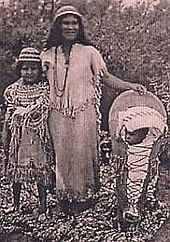
Nomadic Paleo-Indians traveled to the Las Vegas area 10,000 years ago, leaving behind petroglyphs. Ancient Puebloan and Paiute tribes followed at least 2,000 years ago.[21]
A young Mexican scout named Rafael Rivera is credited as the first non-Native American to encounter the valley, in 1829.[22] Trader Antonio Armijo led a 60-man party along the Spanish Trail to Los Angeles, California, in 1829.[23][24] In 1844, John C. Frémont arrived, and his writings helped lure pioneers to the area. Downtown Las Vegas's Fremont Street is named after him.
Eleven years later, members of the Church of Jesus Christ of Latter-day Saints chose Las Vegas as the site to build a fort halfway between Salt Lake City and Los Angeles, where they would travel to gather supplies. The fort was abandoned several years afterward. The remainder of this Old Mormon Fort can still be seen at the intersection of Las Vegas Boulevard and Washington Avenue.
Las Vegas was founded as a city in 1905, when 110 acres (45 ha) of land adjacent to the Union Pacific Railroad tracks were auctioned in what would become the downtown area. In 1911, Las Vegas was incorporated as a city.[25]
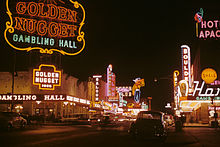
The year 1931 was pivotal for Las Vegas. At that time, Nevada legalized casino gambling[26] and reduced residency requirements for divorce to six weeks.[27] This year also witnessed the beginning of construction of the tunnels of nearby Hoover Dam. The influx of construction workers and their families helped Las Vegas avoid economic calamity during the Great Depression. The construction work was completed in 1935.
In late 1941, Las Vegas Army Airfield was established. Renamed Nellis Air Force Base in 1950, it is now home to the United States Air Force Thunderbirds aerobatic team.[28]
Following World War II, lavishly decorated hotels, gambling casinos, and big-name entertainment became synonymous with Las Vegas.

In 1951, nuclear weapons testing began at the Nevada Test Site, 65 miles (105 km) northwest of Las Vegas. During this time, the city was nicknamed the "Atomic City." Residents and visitors were able to witness the mushroom clouds (and were exposed to the fallout) until 1963 when the Partial Nuclear Test Ban Treaty required that nuclear tests be moved underground.[29]
In 1955, the Moulin Rouge Hotel opened and became the first racially integrated casino-hotel in Las Vegas.
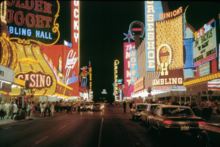
During the 1960s, corporations and business tycoons such as Howard Hughes were building and buying hotel-casino properties. Gambling was referred to as "gaming," which transitioned it into a legitimate business. Learning from Las Vegas, published during this era, asked architects to take inspiration from the city's highly decorated buildings, helping to start the postmodern architecture movement.
In 1995, the Fremont Street Experience opened in Las Vegas's downtown area. This canopied five-block area features 12.5 million LED lights and 550,000 watts of sound from dusk until midnight during shows held at the top of each hour.
Due to the realization of many revitalization efforts, 2012 was dubbed "The Year of Downtown." Projects worth hundreds of millions of dollars made their debut at this time, including the Smith Center for the Performing Arts, the Discovery Children's Museum, the Mob Museum, the Neon Museum, a new City Hall complex, and renovations for a new Zappos.com corporate headquarters in the old City Hall building.[30][31]
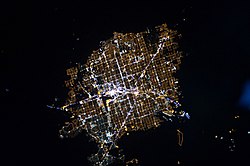
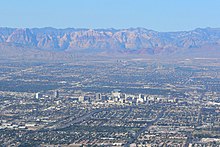
Las Vegas is the county seat of Clark County, in a basin on the floor of the Mojave Desert,[32] and is surrounded by mountain ranges. Much of the landscape is rocky and arid, with desert vegetation and wildlife. It can be subjected to torrential flash floods, although much has been done to mitigate the effects of flash floods through improved drainage systems.[33]
The city's elevation is approximately 2,030 ft (620 m) above sea level, though the surrounding peaks reach elevations of over 10,000 feet (3,000 m) and act as barriers to the strong flow of moisture from the surrounding area. According to the United States Census Bureau, the city has an area of 135.86 sq mi (351.9 km2), of which 135.81 sq mi (351.7 km2) is land and 0.05 sq mi (0.13 km2) (0.03%) is water.
After Alaska and California, Nevada is the third most seismically active state in the U.S. It has been estimated by the United States Geological Survey (USGS) that over the next 50 years, there is a 10–20% chance of an M6.0 or greater earthquake occurring within 50 km (31 mi) of Las Vegas.[34]
Within the city are many lawns, trees, and other greenery. Due to water resource issues, there has been a movement to encourage xeriscapes. Another part of conservation efforts is scheduled watering days for residential landscaping. A U.S. Environmental Protection Agency grant in 2008 funded a program that analyzed and forecast growth and environmental effects through 2019.[35]
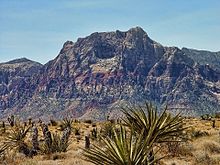

Las Vegas has a subtropical hot desert climate (Köppen climate classification: BWh, Trewartha climate classification BWhk), typical of the Mojave Desert in which it lies. This climate is typified by long, extremely hot summers; warm transitional seasons; and short winters with mild days and cool nights. There is abundant sunshine throughout the year, with an average of 310 sunny days and bright sunshine during 86% of all daylight hours.[36][37] Rainfall is scarce, with an average of 4.2 in (110 mm) dispersed between roughly 26 total rainy days per year.[38] Las Vegas is among the sunniest, driest, and least humid locations in North America, with exceptionally low dew points and humidity that sometimes remains below 10%.[39]
The summer months of June through September are extremely hot, though moderated by the low humidity levels. July is the hottest month, with an average daytime high of 104.5 °F (40.3 °C). On average, 137 days per year reach or exceed 90 °F (32 °C), of which 78 days reach 100 °F (38 °C) and 10 days reach 110 °F (43 °C). During the peak intensity of summer, overnight lows frequently remain above 80 °F (27 °C), and occasionally above 85 °F (29 °C).[36]
While most summer days are consistently hot, dry, and cloudless, the North American Monsoon sporadically interrupts this pattern and brings more cloud cover, thunderstorms, lightning, increased humidity, and brief spells of heavy rain. Potential monsoons affect Las Vegas between July and August. Summer in Las Vegas is marked by significant diurnal temperature variation. While less extreme than other parts of the state, nighttime lows in Las Vegas are often 30 °F (16.7 °C) or more lower than daytime highs.[40] The average hottest night of the year is 90 °F (32 °C). The all-time record is at 95 °F (35 °C).[36]
Las Vegas winters are relatively short, with typically mild daytime temperatures and chilly nights. Sunshine is abundant in all seasons. December is both the year's coolest and cloudiest month, with an average daytime high of 56.9 °F (13.8 °C) and sunshine occurring during 78% of its daylight hours. Winter evenings are defined by clear skies and swift drops in temperature after sunset, with overnight minima averaging around 40 °F (4.4 °C) in December and January. Owing to its elevation that ranges from 2,000 to 3,000 feet (610 to 910 m), Las Vegas experiences markedly cooler winters than other areas of the Mojave Desert and the adjacent Sonoran Desert that are closer to sea level. The city records freezing temperatures an average of 10 nights per winter. It is exceptionally rare for temperatures to reach or fall below 25 °F (−4 °C).[36]

Most of the annual precipitation falls during the winter. February, the wettest month, averages only four days of measurable rain. The mountains immediately surrounding the Las Vegas Valley accumulate snow every winter, but significant accumulation within the city is rare, although moderate accumulations occur every few years. The most recent accumulations occurred on February 18, 2019, when parts of the city received about 1 to 2 inches (2.5 to 5.1 cm) of snow[41] and on February 20 when the city received almost 0.5 inches (1.3 cm).[42] Other recent significant snow accumulations occurred on December 25, 2015, and December 17, 2008.[43] Unofficially, Las Vegas's largest snowfall on record was the 12 inches (30 cm) that fell in 1909.[44] In recent times, ice days have not occurred, although 29 °F (−2 °C) was measured in 1963.[36] On average the coldest day is 44 °F (7 °C).[36]
The highest temperature officially observed for Las Vegas is 120 °F (48.9 °C), as measured at Harry Reid International Airport on July 7, 2024.[36][45] The lowest temperature was 8 °F (−13 °C), recorded on two days: January 25, 1937, and January 13, 1963.[36] The official record hot daily minimum is 95 °F (35 °C) on July 19, 2005, and July 1, 2013. The official record cold daily maximum is 28 °F (−2 °C) on January 8 and 21, 1937.[36] July 2024 was the hottest month ever recorded in Las Vegas, with its highest recorded mean daily average temperature over the month of 99.9 °F (38 °C), its highest recorded mean daily maximum temperature of 111.5 °F (44 °C), and its highest recorded mean nightly minimum temperature of 88.3 °F (31 °C).[46]
Due to concerns about climate change in the wake of a 2002 drought, daily water consumption has been reduced from 314 US gallons (1,190 L) per resident in 2003 to around 205 US gallons (780 L) in 2015.[47]
| Climate data for Harry Reid International Airport (Paradise, Nevada), 1991–2020 normals,[b] extremes 1937–present | |||||||||||||
|---|---|---|---|---|---|---|---|---|---|---|---|---|---|
| Month | Jan | Feb | Mar | Apr | May | Jun | Jul | Aug | Sep | Oct | Nov | Dec | Year |
| Record high °F (°C) | 77 (25) |
87 (31) |
92 (33) |
99 (37) |
109 (43) |
117 (47) |
120 (49) |
116 (47) |
114 (46) |
104 (40) |
87 (31) |
78 (26) |
120 (49) |
| Mean maximum °F (°C) | 68.7 (20.4) |
74.2 (23.4) |
84.3 (29.1) |
93.6 (34.2) |
101.8 (38.8) |
110.1 (43.4) |
112.9 (44.9) |
110.3 (43.5) |
105.0 (40.6) |
94.6 (34.8) |
80.5 (26.9) |
67.9 (19.9) |
113.6 (45.3) |
| Mean daily maximum °F (°C) | 58.5 (14.7) |
62.9 (17.2) |
71.1 (21.7) |
78.5 (25.8) |
88.5 (31.4) |
99.4 (37.4) |
104.5 (40.3) |
102.8 (39.3) |
94.9 (34.9) |
81.2 (27.3) |
67.1 (19.5) |
56.9 (13.8) |
80.5 (26.9) |
| Daily mean °F (°C) | 49.5 (9.7) |
53.5 (11.9) |
60.8 (16.0) |
67.7 (19.8) |
77.3 (25.2) |
87.6 (30.9) |
93.2 (34.0) |
91.7 (33.2) |
83.6 (28.7) |
70.4 (21.3) |
57.2 (14.0) |
48.2 (9.0) |
70.1 (21.2) |
| Mean daily minimum °F (°C) | 40.5 (4.7) |
44.1 (6.7) |
50.5 (10.3) |
56.9 (13.8) |
66.1 (18.9) |
75.8 (24.3) |
82.0 (27.8) |
80.6 (27.0) |
72.4 (22.4) |
59.6 (15.3) |
47.3 (8.5) |
39.6 (4.2) |
59.6 (15.3) |
| Mean minimum °F (°C) | 29.8 (−1.2) |
32.9 (0.5) |
38.7 (3.7) |
45.2 (7.3) |
52.8 (11.6) |
62.2 (16.8) |
72.9 (22.7) |
70.8 (21.6) |
60.8 (16.0) |
47.4 (8.6) |
35.2 (1.8) |
29.0 (−1.7) |
27.4 (−2.6) |
| Record low °F (°C) | 8 (−13) |
16 (−9) |
19 (−7) |
31 (−1) |
38 (3) |
48 (9) |
56 (13) |
54 (12) |
43 (6) |
26 (−3) |
15 (−9) |
11 (−12) |
8 (−13) |
| Average precipitation inches (mm) | 0.56 (14) |
0.80 (20) |
0.42 (11) |
0.20 (5.1) |
0.07 (1.8) |
0.04 (1.0) |
0.38 (9.7) |
0.32 (8.1) |
0.32 (8.1) |
0.32 (8.1) |
0.30 (7.6) |
0.45 (11) |
4.18 (106) |
| Average snowfall inches (cm) | 0.0 (0.0) |
0.0 (0.0) |
0.0 (0.0) |
0.0 (0.0) |
0.0 (0.0) |
0.0 (0.0) |
0.0 (0.0) |
0.0 (0.0) |
0.0 (0.0) |
0.0 (0.0) |
0.0 (0.0) |
0.2 (0.51) |
0.2 (0.51) |
| Average precipitation days (≥ 0.01 in) | 3.1 | 4.1 | 2.8 | 1.6 | 1.1 | 0.4 | 2.5 | 2.2 | 1.8 | 1.7 | 1.5 | 3.0 | 25.8 |
| Average snowy days (≥ 0.1 in) | 0.0 | 0.1 | 0.0 | 0.0 | 0.0 | 0.0 | 0.0 | 0.0 | 0.0 | 0.0 | 0.0 | 0.1 | 0.2 |
| Average relative humidity (%) | 45.1 | 39.6 | 33.1 | 25.0 | 21.3 | 16.5 | 21.1 | 25.6 | 25.0 | 28.8 | 37.2 | 45.0 | 30.3 |
| Average dew point °F (°C) | 22.1 (−5.5) |
23.7 (−4.6) |
23.9 (−4.5) |
24.1 (−4.4) |
28.2 (−2.1) |
30.9 (−0.6) |
40.6 (4.8) |
44.1 (6.7) |
37.0 (2.8) |
30.4 (−0.9) |
25.3 (−3.7) |
22.3 (−5.4) |
29.4 (−1.5) |
| Mean monthly sunshine hours | 245.2 | 246.7 | 314.6 | 346.1 | 388.1 | 401.7 | 390.9 | 368.5 | 337.1 | 304.4 | 246.0 | 236.0 | 3,825.3 |
| Percentage possible sunshine | 79 | 81 | 85 | 88 | 89 | 92 | 88 | 88 | 91 | 87 | 80 | 78 | 86 |
| Source: NOAA (relative humidity, dew point and sun 1961–1990)[36][38][37] | |||||||||||||
|
|
Graphs are unavailable due to technical issues. Updates on reimplementing the Graph extension, which will be known as the Chart extension, can be found on Phabricator and on MediaWiki.org.
|
See or edit raw graph data.

| Census | Pop. | Note | %± |
|---|---|---|---|
| 1900 | 25 | — | |
| 1910 | 800 | 3,100.0% | |
| 1920 | 2,304 | 188.0% | |
| 1930 | 5,165 | 124.2% | |
| 1940 | 8,422 | 63.1% | |
| 1950 | 24,624 | 192.4% | |
| 1960 | 64,405 | 161.6% | |
| 1970 | 125,787 | 95.3% | |
| 1980 | 164,674 | 30.9% | |
| 1990 | 258,295 | 56.9% | |
| 2000 | 478,434 | 85.2% | |
| 2010 | 583,756 | 22.0% | |
| 2020 | 641,903 | 10.0% | |
| 2022 (est.) | 656,274 | 2.2% | |
| source:[48][49] 2010–2010[9] |
|||
| Race / Ethnicity (NH = Non-Hispanic) | Pop 2000[50] | Pop 2010[51] | Pop 2020[52] | % 2000 | % 2010 | % 2020 |
|---|---|---|---|---|---|---|
| White alone (NH) | 277,704 | 279,703 | 259,561 | 58.04% | 47.91% | 40.44% |
| Black or African American alone (NH) | 48,380 | 62,008 | 79,129 | 10.11% | 10.62% | 12.33% |
| Native American or Alaska Native alone (NH) | 2,405 | 2,391 | 2,291 | 0.50% | 0.41% | 0.36% |
| Asian alone (NH) | 22,411 | 34,606 | 44,995 | 4.68% | 5.93% | 7.01% |
| Pacific Islander alone (NH) | 1,935 | 3,103 | 4,204 | 0.40% | 0.53% | 0.65% |
| Other race alone (NH) | 650 | 1,101 | 3,855 | 0.14% | 0.19% | 0.60% |
| Mixed race or Multiracial (NH) | 11,987 | 16,985 | 34,040 | 2.51% | 2.91% | 5.30% |
| Hispanic or Latino (any race) | 112,962 | 183,859 | 213,828 | 23.61% | 31.50% | 33.31% |
| Total | 474,434 | 583,756 | 641,903 | 100.00% | 100.00% | 100.00% |
According to the 2020 United States census, the city of Las Vegas had 644,883 people living in 244,429 households. The racial composition of the City of Las Vegas was 49.2% white, 11.9% black, 1.1% American Indian or Alaska Native, 6.9% Asian, Hispanic or Latino residents of any race were 34.1% and 16.2% from two or more races. 40.8% were non-Hispanic white.[53]
Approximately 5.8% of residents are under the age of five, 22.8% under the age of eighteen and 15.6% over 65 years old. Females are 50.0% of the total population.[53]

⬤ Black
⬤ Asian
⬤ Hispanic
⬤ Other
From 2019 to 2023, Las Vegas had approximately 244,429 households, with an average of 2.63 persons per household. About 55.7% of housing units were owner-occupied, and the median value of owner-occupied housing was $395,300. Median gross rent during this period was $1,456 per month (in 2023 dollars).[53]
The median household income in Las Vegas from 2019 to 2023 was $70,723, while the per capita income was $38,421 (in 2023 dollars). Approximately 14.2% of the population lived below the poverty line during the same period.[53]
Residents over 25 years old with a high school diploma were 85.8% of the population with 27.3% having attained a bachelor's degree or higher.[53]
About 33.0% of residents aged 5 and older speak a language other than English at home. 20.9% of residents are foreign-born.[53]
The mean travel time to work for residents aged 16 and older was approximately 25.8 minutes between 2019 and 2023. The vast majority of households in Las Vegas are digitally connected, with 95.6% having a computer and 89.1% subscribing to broadband internet services .
According to demographer William H. Frey using data from the 2010 United States census, Las Vegas has the second-lowest level of black-white segregation of any of the 100 largest U.S. metropolitan areas after Tucson, Arizona.[54]
According to the Las Vegas Asian Chamber of Commerce, Filipinos make up the largest ethnic population within Vegas. at 20% of the city's population.[55] Native Hawaiians are also a major demographic in the city, with some Hawaiians and Las Vegas residents calling the city the "ninth island of Hawaii" due to the major influx of Hawaiians to Vegas.[56]
According to a 2004 study, Las Vegas has one of the highest divorce rates.[57][58] The city's high divorce rate is not wholly due to Las Vegans themselves getting divorced. Compared to other states, Nevada's nonrestrictive requirements for divorce result in many couples temporarily moving to Las Vegas in order to get divorced.[59] Similarly, Nevada marriage requirements are equally lax resulting in one of the highest marriage rates of U.S. cities, with many licenses issued to people from outside the area (see Las Vegas weddings).[59]
According to the 2010 Census, the city of Las Vegas had a population of 583,756. The city's racial composition had shifted slightly, with 47.91% of the population identifying as White alone (non-Hispanic), 10.63% as Black or African American alone (non-Hispanic), 0.41% as Native American or Alaska Native alone (non-Hispanic), 5.93% as Asian alone (non-Hispanic), 0.53% as Pacific Islander alone (non-Hispanic), 0.19% as Other Race alone (non-Hispanic), and 2.91% as Mixed race or Multiracial (non-Hispanic). Hispanic or Latino individuals of any race represented 31.50% of the population.[51]
According to the 2000 census, Las Vegas had a population of 474,434 people. The racial makeup of the city was 58.52% White alone (non-Hispanic), 10.19% Black or African American alone (non-Hispanic), 0.51% Native American or Alaska Native alone (non-Hispanic), 4.72% Asian alone (non-Hispanic), 0.41% Pacific Islander alone (non-Hispanic), 0.14% Other Race alone (non-Hispanic), and 2.52% Mixed race or Multiracial (non-Hispanic). Hispanic or Latino individuals of any race made up 23.81% of the population.[50]
| Historical racial profile | 2020[60] | 2010[61] | 2000[62] | 1990[63] | 1970[63] |
|---|---|---|---|---|---|
| White | 46.0% | 62.1% | 69.9% | 78.4% | 87.6% |
| —Non-Hispanic Whites | 40.4% | 47.9% | 58.0% | 72.1% | 83.1%[c] |
| Black or African American | 12.9% | 11.1% | 10.4% | 11.4% | 11.2% |
| Hispanic or Latino (of any race) | 33.3% | 31.5% | 23.6% | 12.5% | 4.6%[c] |
| Asian | 7.2% | 6.1% | 4.8% | 3.6% | 0.7% |
The primary drivers of the Las Vegas economy are tourism, gaming, and conventions, which in turn feed the retail and restaurant industries.
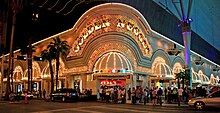


The major attractions in Las Vegas are the casinos and the hotels, although in recent years other new attractions have begun to emerge.
Most casinos in the downtown area are on Fremont Street, with The STRAT Hotel, Casino & Skypod as one of the few exceptions. Fremont East, adjacent to the Fremont Street Experience, was granted variances to allow bars to be closer together, similar to the Gaslamp Quarter of San Diego, the goal being to attract a different demographic than the Strip attracts.
The Golden Gate Hotel and Casino, downtown along the Fremont Street Experience, is the oldest continuously operating hotel and casino in Las Vegas; it opened in 1906 as the Hotel Nevada.
In 1931, the Northern Club (now the La Bayou) opened.[64][65] The most notable of the early casinos may have been Binion's Horseshoe (now Binion's Gambling Hall and Hotel) while it was run by Benny Binion.
Boyd Gaming has a major presence downtown operating the California Hotel & Casino, the Fremont Hotel & Casino, and the Main Street Casino. The Four Queens also operates downtown along the Fremont Street Experience.
Downtown casinos that have undergone major renovations and revitalization in recent years include the Golden Nugget Las Vegas, The D Las Vegas (formerly Fitzgerald's), the Downtown Grand Las Vegas (formerly Lady Luck), the El Cortez Hotel & Casino, and the Plaza Hotel & Casino.[66]
In 2020, Circa Resort & Casino opened, becoming the first all-new hotel-casino to be built on Fremont Street since 1980.[67]
The center of the gambling and entertainment industry is the Las Vegas Strip, outside the city limits in the surrounding unincorporated communities of Paradise and Winchester in Clark County. Some of the largest casinos and buildings are there.[68]
In 1929, the city installed a welcome arch over Fremont Street, at the corner of Main Street.[69][70][71] It remained in place until 1931.[72][73]
In 1959, the 25-foot-tall (7.6 m) Welcome to Fabulous Las Vegas sign was installed at the south end of the Las Vegas Strip. A replica welcome sign, standing nearly 16 feet (4.9 m) tall, was installed within city limits in 2002, at Las Vegas Boulevard and Fourth Street.[74][75][76] The replica was destroyed in 2016, when a pickup truck crashed into it.[77]
In 2018, the city approved plans for a new gateway landmark in the form of neon arches. It was built within city limits, in front of the Strat resort and north of Sahara Avenue.[78] The project, built by YESCO, cost $6.5 million and stands 80 feet (24 m) high.[79] Officially known as the Gateway Arches, the project was completed in 2020. The steel arches are blue during the day, and light up in a variety of colors at night.[80]
Also located just north of the Strat are a pair of giant neon showgirls, initially added in 2018 as part of a $400,000 welcome display. The original showgirls were 25 feet (7.6 m) tall, but were replaced by new ones in 2022, rising 50 feet (15 m).[81][82] The originals were refurbished following weather damage and installed at the Las Vegas Arts District.[82][83]
When The Mirage opened in 1989, it started a trend of major resort development on the Las Vegas Strip outside of the city. This resulted in a drop in tourism in the downtown area, but many recent projects have increased the number of visitors to downtown.
An effort has been made by city officials to diversify the economy by attracting health-related, high-tech and other commercial interests. No state tax for individuals or corporations, as well as a lack of other forms of business-related taxes, have aided the success of these efforts.[84]
The Fremont Street Experience was built in an effort to draw tourists back to the area and has been popular since its startup in 1995.
The city conducted a land-swap deal in 2000 with Lehman Brothers, acquiring 61 acres (25 ha) of property near downtown Las Vegas in exchange for 91 acres (37 ha) of the Las Vegas Technology Center.[85] In 2004, Las Vegas Mayor Oscar Goodman announced that the area would become home to Symphony Park (originally called "Union Park"[86]), a mixed-use development. The development is home to the Cleveland Clinic Lou Ruvo Center for Brain Health, The Smith Center for the Performing Arts, the Discovery Children's Museum, the Las Vegas Chamber of Commerce, and four residential projects totaling 600 residential units as of 2024.[87]

In 2005, the World Market Center opened, consisting of three large buildings taking up 5,400,000 square feet (500,000 m2). Trade shows for the furniture and furnishing industries are held there semiannually.[88]
Also nearby is the Las Vegas North Premium Outlets. With a second expansion, completed in May 2015, the mall currently offers 175 stores.[89]
City offices moved to a new Las Vegas City Hall in February 2013 on downtown's Main Street. The former city hall building is now occupied by the corporate headquarters for the online retailer Zappos.com, which opened downtown in 2013. Zappos CEO Tony Hsieh took an interest in the urban area and contributed $350 million toward a revitalization effort called the Downtown Project.[90][91] Projects funded include Las Vegas's first independent bookstore, The Writer's Block.[92]
A number of new industries have moved to Las Vegas in recent decades. Zappos.com (now an Amazon subsidiary) was founded in San Francisco but by 2013 had moved its headquarters to downtown Las Vegas. Allegiant Air, a low-cost air carrier, launched in 1997 with its first hub at Harry Reid International Airport and headquarters in nearby Summerlin.
Planet 13 Holdings, a cannabis company, opened the world's largest cannabis dispensary in Las Vegas at 112,000 sq ft (10,400 m2).[93][94]
A growing population means the Las Vegas Valley used 1.2 billion US gal (4.5 billion L) more water in 2014 than in 2011. Although water conservation efforts implemented in the wake of a 2002 drought have had some success, local water consumption remains 30 percent greater than in Los Angeles, and over three times that of San Francisco metropolitan area residents. The Southern Nevada Water Authority is building a $1.4 billion tunnel and pumping station to bring water from Lake Mead, has purchased water rights throughout Nevada, and has planned a controversial $3.2 billion pipeline across half the state. By law, the Las Vegas Water Service District "may deny any request for a water commitment or request for a water connection if the District has an inadequate supply of water." But limiting growth on the basis of an inadequate water supply has been unpopular with the casino and building industries.[47]
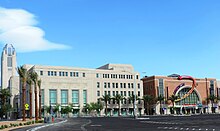
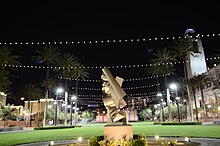
The city is home to several museums, including the Neon Museum (the location for many of the historical signs from Las Vegas's mid-20th century heyday), The Mob Museum, the Las Vegas Natural History Museum, the Discovery Children's Museum, the Nevada State Museum and the Old Las Vegas Mormon Fort State Historic Park.
The city is home to an extensive Downtown Arts District, which hosts numerous galleries and events including the annual Las Vegas Film Festival. "First Friday" is a monthly celebration that includes arts, music, special presentations and food in a section of the city's downtown region called 18b, The Las Vegas Arts District.[95] The festival extends into the Fremont East Entertainment District.[96] The Thursday evening before First Friday is known in the arts district as "Preview Thursday," which highlights new gallery exhibitions throughout the district.[97]
The Las Vegas Academy of International Studies, Performing and Visual Arts is a Grammy award-winning magnet school located in downtown Las Vegas. The Smith Center for the Performing Arts is downtown in Symphony Park and hosts various Broadway shows and other artistic performances.
Las Vegas has earned the moniker "Gambling Capital of the World," as it has the world's most land-based casinos.[98] The city is also host to more AAA Five Diamond hotels than any other city in the world.[99]

The Las Vegas Valley is the home of three major professional teams: the National Hockey League (NHL)'s Vegas Golden Knights, an expansion team that began play in the 2017–18 NHL season at T-Mobile Arena in nearby Paradise,[100] the National Football League (NFL)'s Las Vegas Raiders, who relocated from Oakland, California, in 2020 and play at Allegiant Stadium in Paradise,[101] and the Women's National Basketball Association (WNBA)'s Las Vegas Aces, who play at the Mandalay Bay Events Center. The Oakland Athletics of Major League Baseball (MLB) will move to Las Vegas by 2028.[102][103]
Two minor league sports teams play in the Las Vegas area. The Las Vegas Aviators of the Pacific Coast League, the Triple-A farm club of the Athletics, play at Las Vegas Ballpark in nearby Summerlin.[104] The Las Vegas Lights FC of the United Soccer League play in Cashman Field in Downtown Las Vegas.[105][106]
The mixed martial arts promotion, Ultimate Fighting Championship (UFC), is headquartered in Las Vegas and also frequently holds fights in the city at T-Mobile Arena and at the UFC Apex training facility near the headquarters.[107]
| Team | Sport | League | Venue (capacity) | Established | Titles |
|---|---|---|---|---|---|
| Las Vegas Raiders | Football | NFL | Allegiant Stadium (65,000) | 2020 | 3[d] |
| Vegas Golden Knights | Ice hockey | NHL | T-Mobile Arena (17,500) | 2017 | 1 |
| Las Vegas Aces | Women's basketball | WNBA | Michelob Ultra Arena (12,000) | 2018 | 2 |
| Team | Sport | League | Venue (capacity) | Established | Titles |
|---|---|---|---|---|---|
| Las Vegas Aviators | Baseball | MiLB (AAA-PCL) | Las Vegas Ballpark (10,000) | 1983 | 2 |
| Henderson Silver Knights | Ice hockey | AHL | Lee's Family Forum (5,567) | 2020 | 0 |
| Las Vegas Lights FC | Soccer | USLC | Cashman Field (9,334) | 2018 | 0 |
| Vegas Knight Hawks | Indoor football | IFL | Lee's Family Forum (6,019) | 2021 | 0 |
| Las Vegas Desert Dogs | Box lacrosse | NLL | Lee's Family Forum (5,567) | 0 |
| Team | Sport | League | Venue (capacity) | Established | Titles |
|---|---|---|---|---|---|
| Las Vegas Dream | Basketball | ABA | 2023 | ||
| Las Vegas Royals | 2020 | ||||
| Vegas Jesters | Ice hockey | MWHL | City National Arena (600) | 2012 | 0 |
| Las Vegas Thunderbirds | USPHL | 2019 | 0 | ||
| Las Vegas Legends | Soccer | NPSL | Peter Johann Memorial Field (2,500) | 2021 | 0 |
| Vegas NVaders | Women's football | WFA - D2 | Desert Pines High School (N/A) | 2023 | 0 |
| School | Team | League | Division | Primary Conference |
|---|---|---|---|---|
| University of Nevada, Las Vegas (UNLV) | UNLV Rebels | NCAA | NCAA Division I | Mountain West |
| College of Southern Nevada (CSN) | CSN Coyotes | NJCAA | NJCAA Division I | Scenic West |

The city's parks and recreation department operates 78 regional, community, neighborhood, and pocket parks; four municipal swimming poools, 11 recreational centers, four active adult centers, eight cultural centers, six galleries, eleven dog parks, and four golf courses: Angel Park Golf Club, Desert Pines Golf Club, Durango Hills Golf Club, and the Las Vegas Municipal Golf Course.[108]
It is also responsible for 123 playgrounds, 23 softball fields, 10 football fields, 44 soccer fields, 10 dog parks, six community centers, four senior centers, 109 skate parks, and six swimming pools.[109]
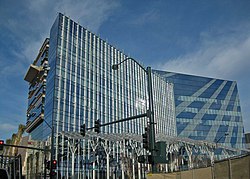
The city of Las Vegas has a council–manager government.[110] The mayor sits as a council member-at-large and presides over all city council meetings.[110] If the mayor cannot preside over a city council meeting, then the Mayor pro tempore is the presiding officer of the meeting until the Mayor returns to his/her seat.[111] The city manager is responsible for the administration and the day-to-day operations of all municipal services and city departments.[112] The city manager maintains intergovernmental relationships with federal, state, county and other local governments.[112]
Out of the 2,265,461 people in Clark County as of the 2020 Census, approximately 1,030,000 people live in unincorporated Clark County, and around 650,000 live in incorporated cities such as North Las Vegas, Henderson and Boulder City.[113] Las Vegas and Clark County share a police department, the Las Vegas Metropolitan Police Department, which was formed after a 1973 merger of the Las Vegas Police Department and the Clark County Sheriff's Department.[114] North Las Vegas, Henderson, Boulder City, Mesquite, UNLV and CCSD have their own police departments.[115]
The federally-recognized Las Vegas Tribe of Paiute Indians (Southern Paiute: Nuvagantucimi) occupies a 31-acre (130,000 m2) reservation just north downtown between Interstate-15 and Main Street.[116][117][118]
Downtown is the location of Lloyd D. George Federal District Courthouse[119] and the Regional Justice Center,[120] draws numerous companies providing bail, marriage, divorce, tax, incorporation and other legal services.
| Name | Position | Party | References | Notes |
|---|---|---|---|---|
| Shelley Berkley | Mayor | Democratic | [121] | |
| Brian Knudsen | 1st Ward Council member | Democratic | [122][123] | Mayor Pro Tem |
| Victoria Seaman | 2nd Ward Council member | Republican | [124][123] | |
| Olivia Diaz | 3rd Ward Council member | Democratic | [125][123] | |
| Francis Allen-Palenske | 4th Ward Council member | Republican | ||
| Shondra Summers-Armstrong | 5th Ward Council member | Democratic | [126] | |
| Nancy Brune | 6th Ward Council member | Democratic |
Primary and secondary public education is provided by the Clark County School District.[127]
Public higher education is provided by the Nevada System of Higher Education (NSHE). Public institutions serving Las Vegas include the University of Nevada, Las Vegas (UNLV), the College of Southern Nevada (CSN), Nevada State University (NSU), and the Desert Research Institute (DRI).[128]
UNLV is a public, land-grant, R1 research university and is home to the Kirk Kerkorian School of Medicine[129] and the William S. Boyd School of Law, the only law school in Nevada.[130] The university's campus is urban and located about two miles east of the Las Vegas strip. The Desert Research Institute's southern campus sits next to UNLV, while its northern campus is in Reno.[131]
CSN, with campuses throughout Clark County,[132] is a community college with one of the largest enrollments in the United States.[133] In unincorporated Clark County, CSN's Charleston campus is home to the headquarters of Nevada Public Radio (KNPR), an NPR member station.[134][135]
Touro University Nevada located in Henderson is a non-profit, private institution primarily focusing on medical education.[136] Other institutions include a number of for-profit private schools (e.g., Le Cordon Bleu College of Culinary Arts, DeVry University, among others).[137]

Las Vegas is served by 10 full power television stations and 46 radio stations. The area is also served by two NOAA Weather Radio transmitters (162.55 MHz located in Boulder City and 162.40 MHz located on Potosi Mountain).
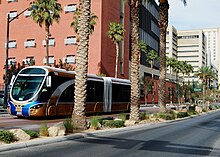


RTC Transit is a public transportation system providing bus service throughout Las Vegas, Henderson, North Las Vegas and other areas of the valley. Inter-city bus service to and from Las Vegas is provided by Greyhound, BoltBus, Orange Belt Stages, Tufesa, and several smaller carriers.[144]
Amtrak trains have not served Las Vegas since the service via the Desert Wind at Las Vegas station ceased in 1997, but Amtrak California operates Amtrak Thruway dedicated service between the city and its passenger rail stations in Bakersfield, California, as well as Los Angeles Union Station via Barstow.[145]
High-speed rail project Brightline West began construction in 2024 to connect Brightline's Las Vegas station and the Rancho Cucamonga station in Greater Los Angeles.[146]
The Las Vegas Monorail on the Strip was privately built, and upon bankruptcy taken over by the Las Vegas Convention and Visitors Authority.[147]
Silver Rider Transit operates three routes within Las Vegas, offering connections to Laughlin,[148] Mesquite,[149] and Sandy Valley.[150]
The Union Pacific Railroad is the only Class I railroad providing rail freight service to the city. Until 1997, the Amtrak Desert Wind train service ran through Las Vegas using the Union Pacific Railroad tracks.
In March 2010, the RTC launched bus rapid transit link in Las Vegas called the Strip & Downtown Express with limited stops and frequent service that connects downtown Las Vegas, the Strip and the Las Vegas Convention Center. Shortly after the launch, the RTC dropped the ACE name.[151]
In 2016, 77.1 percent of working Las Vegas residents (those living in the city, but not necessarily working in the city) commuted by driving alone. About 11 percent commuted via carpool, 3.9 percent used public transportation, and 1.4 percent walked. About 2.3 percent of Las Vegas commuters used all other forms of transportation, including taxi, bicycle, and motorcycle. About 4.3% of working Las Vegas residents worked at home.[152] In 2015, 10.2 percent of city of Las Vegas households were without a car, which increased slightly to 10.5 percent in 2016. The national average was 8.7 percent in 2016. Las Vegas averaged 1.63 cars per household in 2016, compared to a national average of 1.8 per household.
With some exceptions, including Las Vegas Boulevard, Boulder Highway (SR 582) and Rancho Drive (SR 599), the majority of surface streets in Las Vegas are laid out in a grid along Public Land Survey System section lines. Many are maintained by the Nevada Department of Transportation as state highways. The street numbering system is divided by the following streets:
Interstates 15, 11, and US 95 lead out of the city in four directions. Two major freeways – Interstate 15 and Interstate 11/U.S. Route 95 – cross in downtown Las Vegas. I-15 connects Las Vegas to Los Angeles, and heads northeast to and beyond Salt Lake City. I-11 goes northwest to the Las Vegas Paiute Indian Reservation and southeast to Henderson and to the Mike O'Callaghan–Pat Tillman Memorial Bridge, where from this point I-11 will eventually continue along US 93 towards Phoenix, Arizona. US 95 (and eventually I-11) connects the city to northwestern Nevada, including Carson City and Reno. US 93 splits from I-15 northeast of Las Vegas and goes north through the eastern part of the state, serving Ely and Wells. US 95 heads south from US 93 near Henderson through far eastern California. A partial beltway has been built, consisting of Interstate 215 on the south and Clark County 215 on the west and north. Other radial routes include Blue Diamond Road (SR 160) to Pahrump and Lake Mead Boulevard (SR 147) to Lake Mead.
East–west roads, north to south[153]
Harry Reid International Airport handles international and domestic flights into the Las Vegas Valley. The airport also serves private aircraft and freight/cargo flights. Most general aviation traffic uses the smaller North Las Vegas Airport and Henderson Executive Airport.
Exposures 50 years ago still have health implications today that will continue into the future...Deposition...generally decreases with distance from the test site in the direction of the prevailing wind across North America, although isolated locations received significant deposition as a result of rainfall. Trajectories of the fallout debris clouds across the U.S. are shown for four altitudes. Each dot indicates six hours.
"Probability of an earthquake of magnitude 6.0 or greater occurring within 50 km in 50 years (from USGS probabilistic seismic hazard analysis) 10–20% chance for Las Vegas area, magnitude 6".
Workers were great, no problem they did what was required, but the representative of your company mislead me on what was to be done, I showed pictures from a competitor landscaper, representative stated he could bet there , , . price, but since it wasn’t in contract, I was left with uncomplicated backyard , working with owner at present, so he’s been outstanding working on this situation, as amount of rock was way off and the owner did increase the amount substantially to finish the front yard. another landscaper under contract to finish the backyard. Would like to add a comment the manger/owner of Las Vegas yard n block stands behind his words and helped me tremendously on finishing up the backyard,
Eric and team did an amazing job. They worked with me for months while I got HOA approval for the project. Once they began working they were great, going over everything in detail and making sure things were perfect. This project included wall repair, stucco and paint repair, paver and turf installation. Extremely satisfied with this experience.
Chris, the design consultant, Dave the production manager, along with their install team Opulent were affordable, upfront with costs, efficient and professional. Attached are some before and after pictures. Highly recommend their services.
My initial contact was with Ray, whom did an excellent job giving me an estimate on what I wanted done in my small yard and walkway., the guys that came out and did the work were superior. They did an excellent job. I’m very pleased with this company. I will highly recommend them to family and friends, and I will be using them in the near future for other little projects.
We recently had a very positive experience with Rock N Block for our fence replacement. The entire process went smoothly and exceeded our expectations. Harvey and his team were incredibly professional and communicative throughout the project providing much-needed assurance and peace of mind. The crew was punctual and maintained a diligent and respectful attitude that made the experience pleasant. The crew finished the project ahead of schedule, and the quality of their work is impressive; our new wall looks great! We recommend Rock N Block for any fencing needs and look forward to working with them again. Thank you, Harvey and crew, for a job well done!
Workers were great, no problem they did what was required, but the representative of your company mislead me on what was to be done, I showed pictures from a competitor landscaper, representative stated he could bet there , , . price, but since it wasn’t in contract, I was left with uncomplicated backyard , working with owner at present, so he’s been outstanding working on this situation, as amount of rock was way off and the owner did increase the amount substantially to finish the front yard. another landscaper under contract to finish the backyard. Would like to add a comment the manger/owner of Las Vegas yard n block stands behind his words and helped me tremendously on finishing up the backyard,
My initial contact was with Ray, whom did an excellent job giving me an estimate on what I wanted done in my small yard and walkway., the guys that came out and did the work were superior. They did an excellent job. I’m very pleased with this company. I will highly recommend them to family and friends, and I will be using them in the near future for other little projects.
Chris, the design consultant, Dave the production manager, along with their install team Opulent were affordable, upfront with costs, efficient and professional. Attached are some before and after pictures. Highly recommend their services.
Eric and team did an amazing job. They worked with me for months while I got HOA approval for the project. Once they began working they were great, going over everything in detail and making sure things were perfect. This project included wall repair, stucco and paint repair, paver and turf installation. Extremely satisfied with this experience.